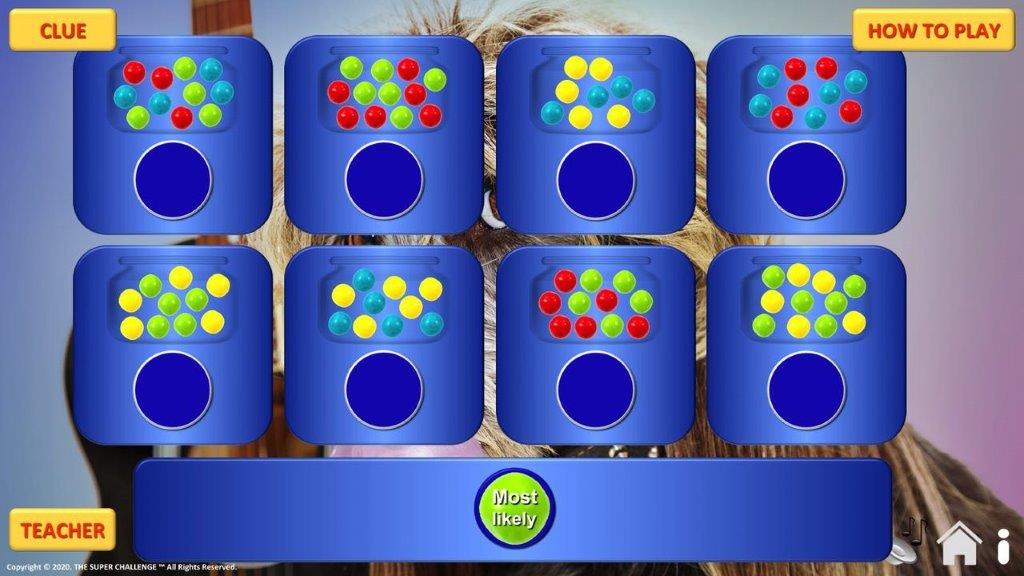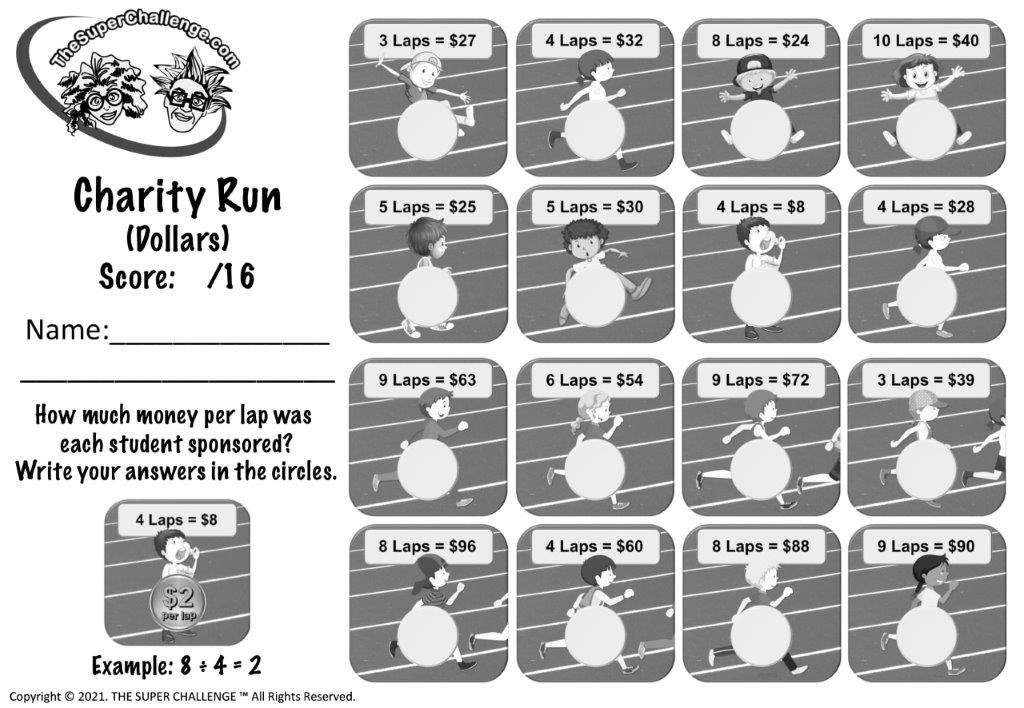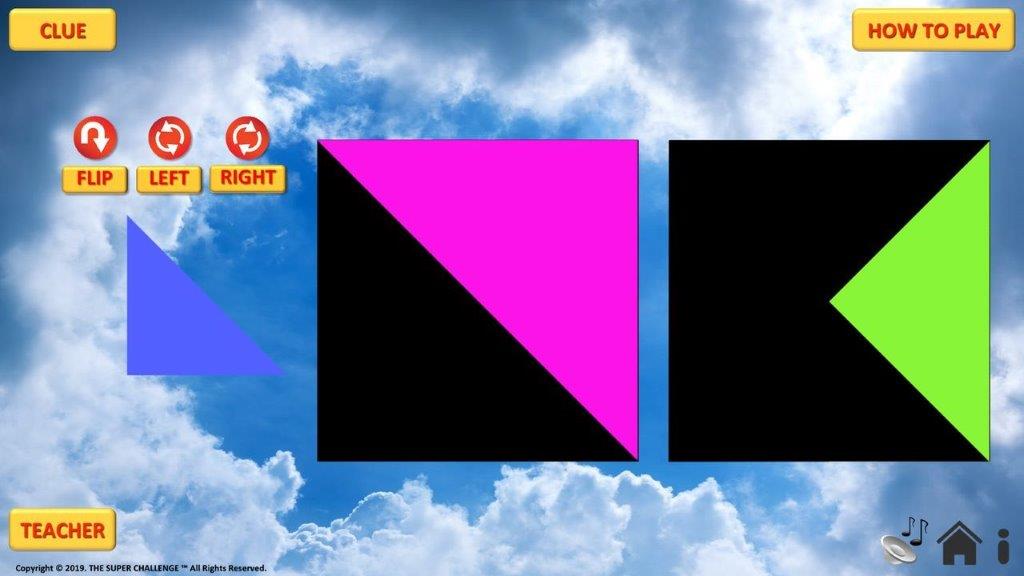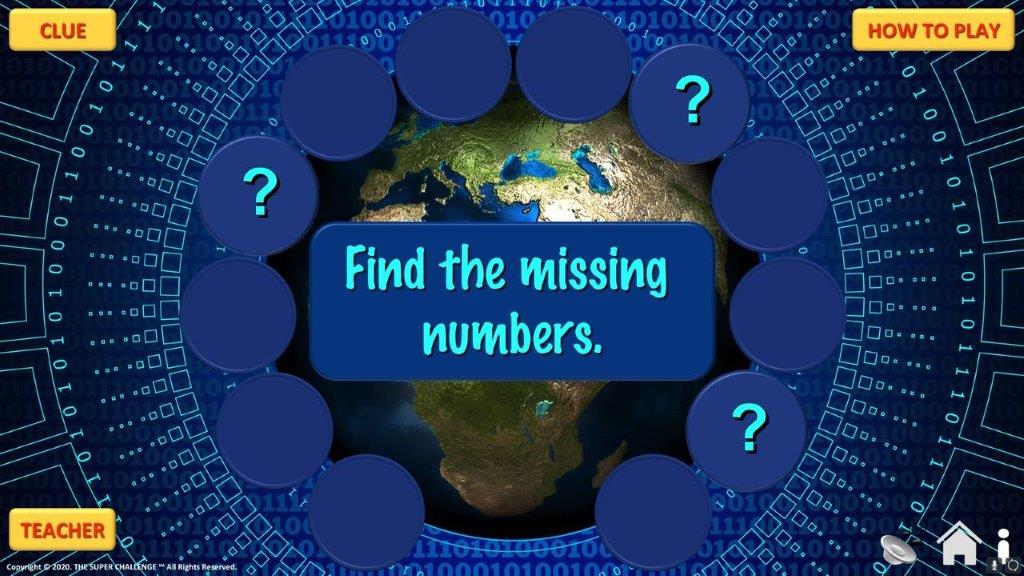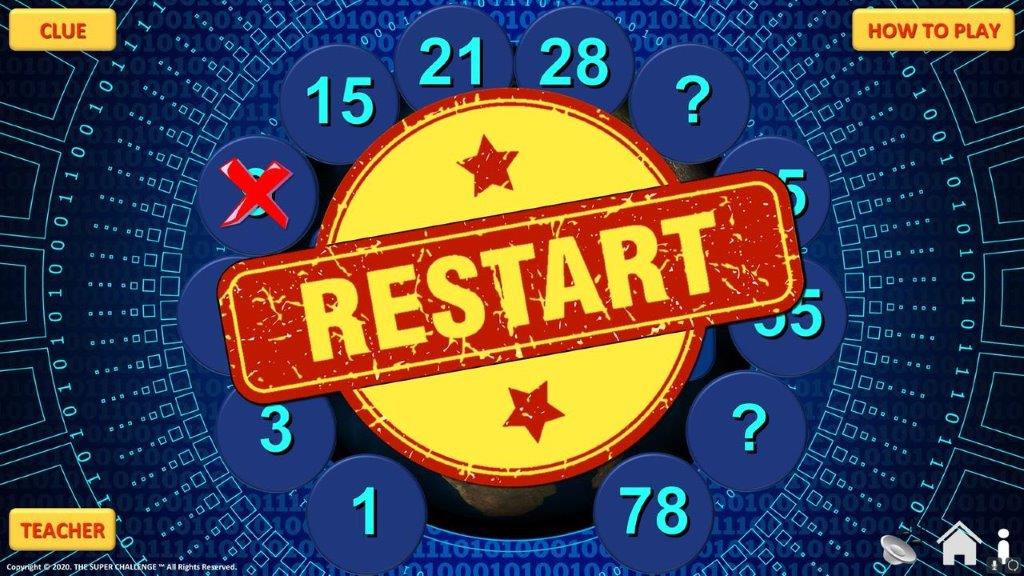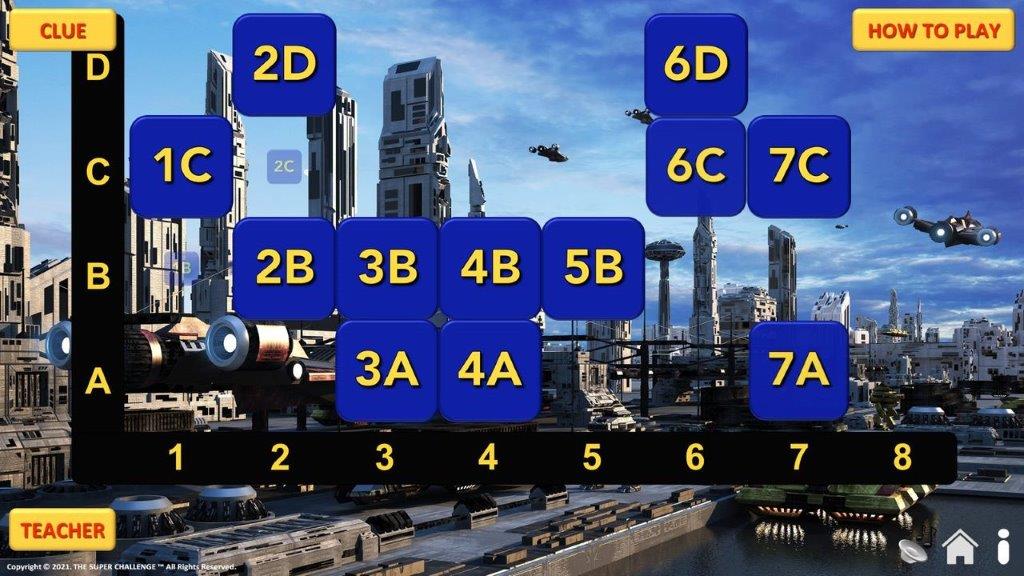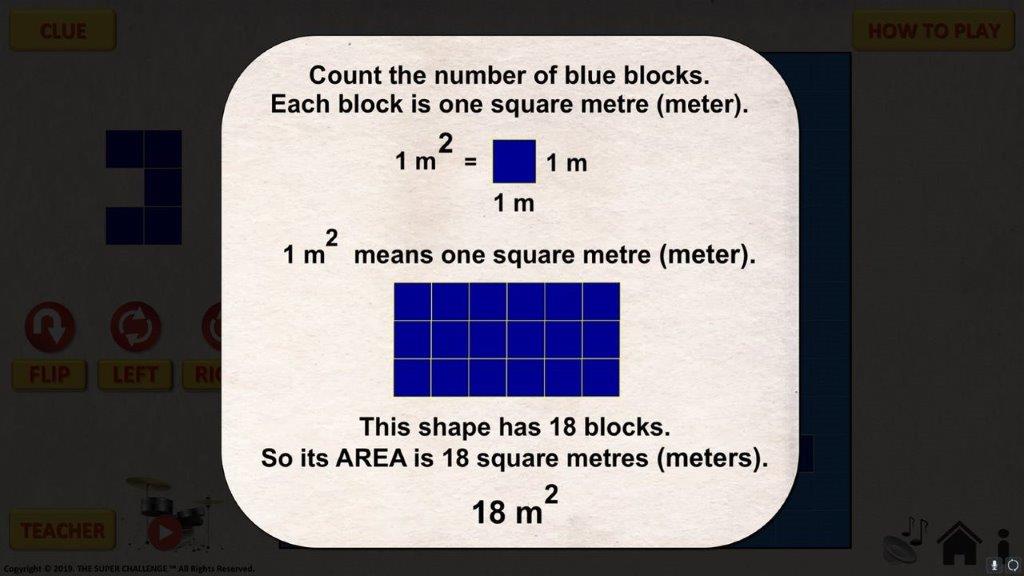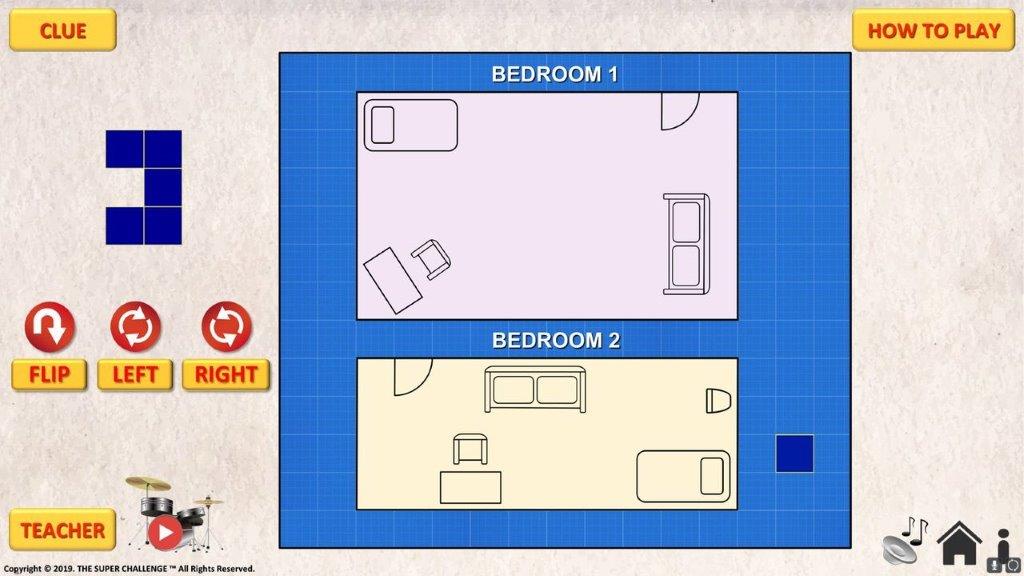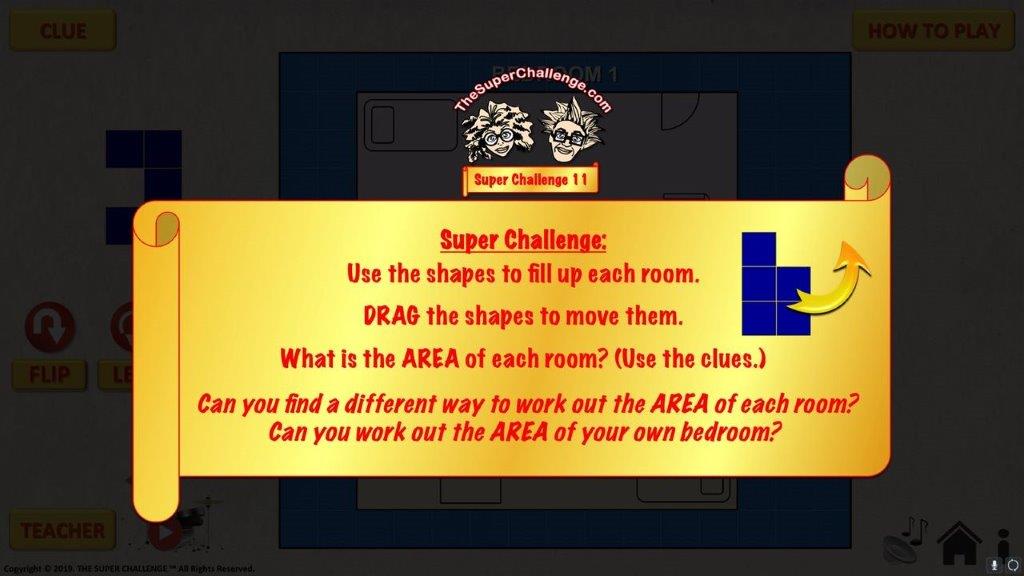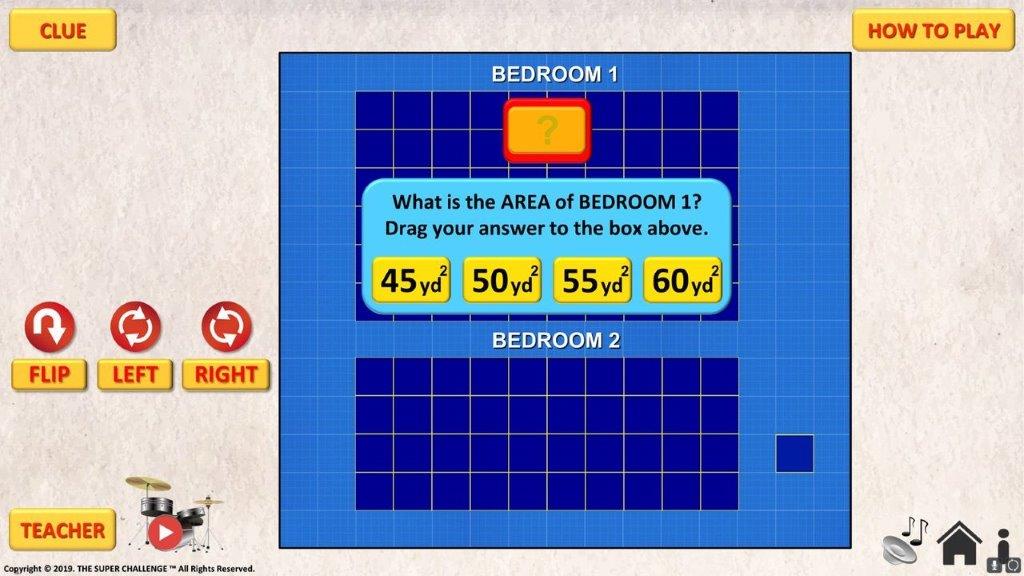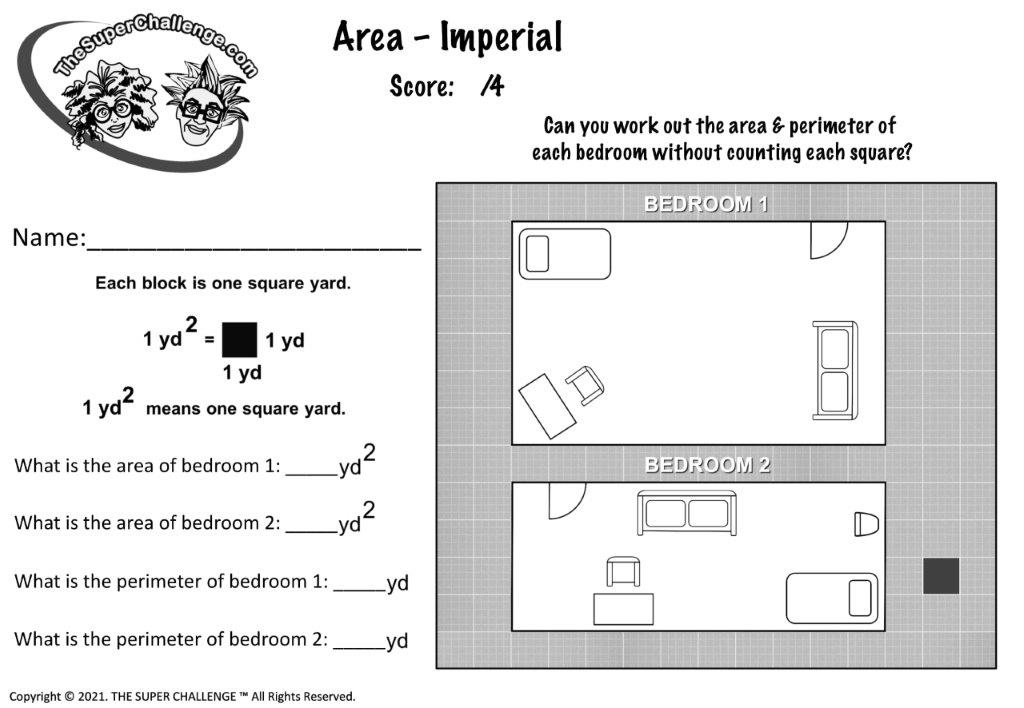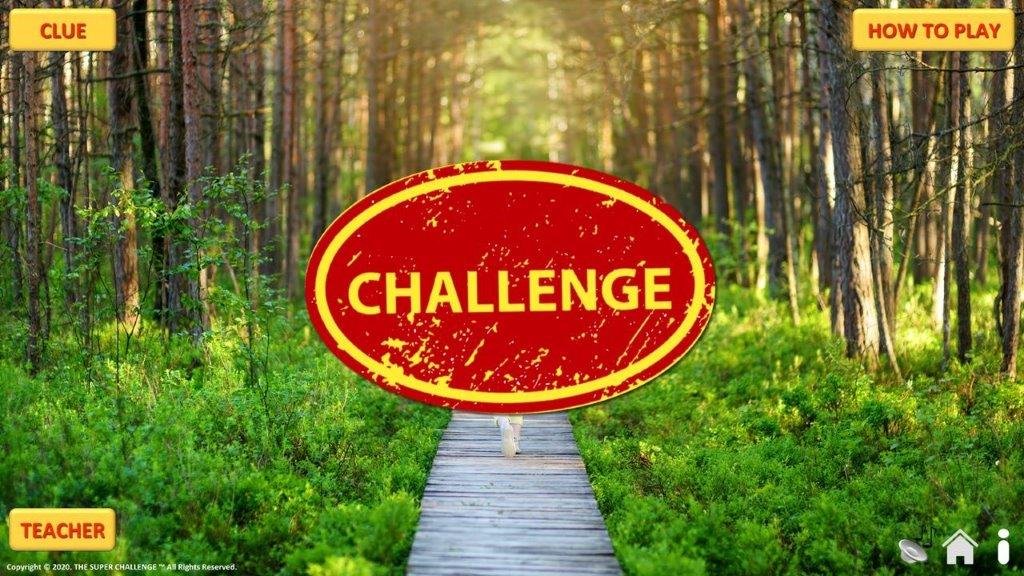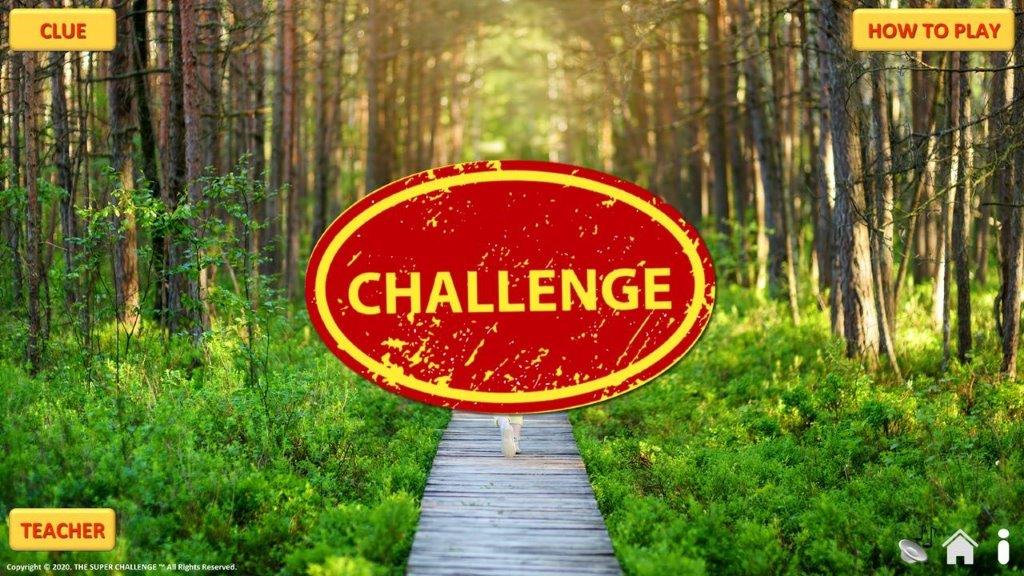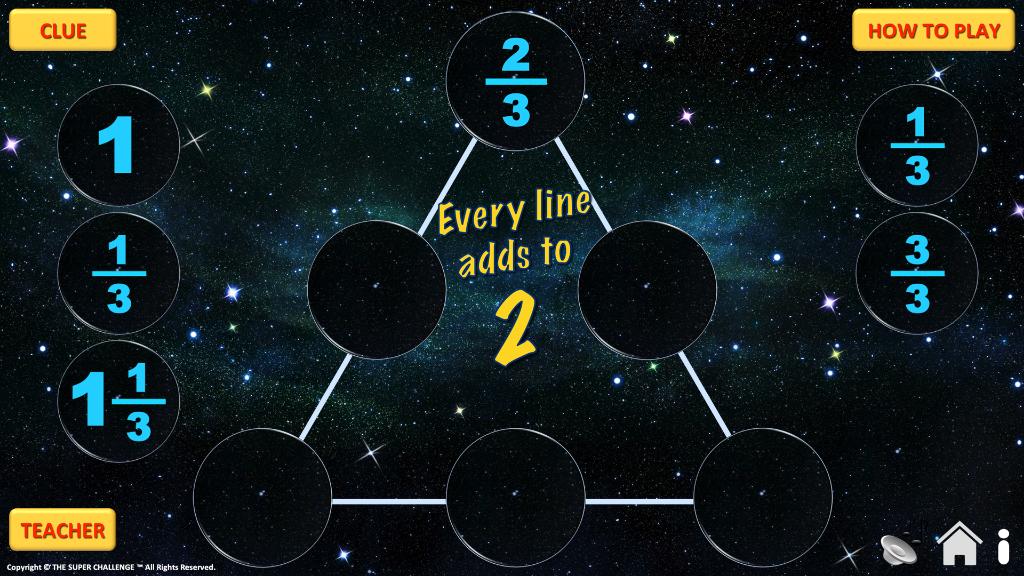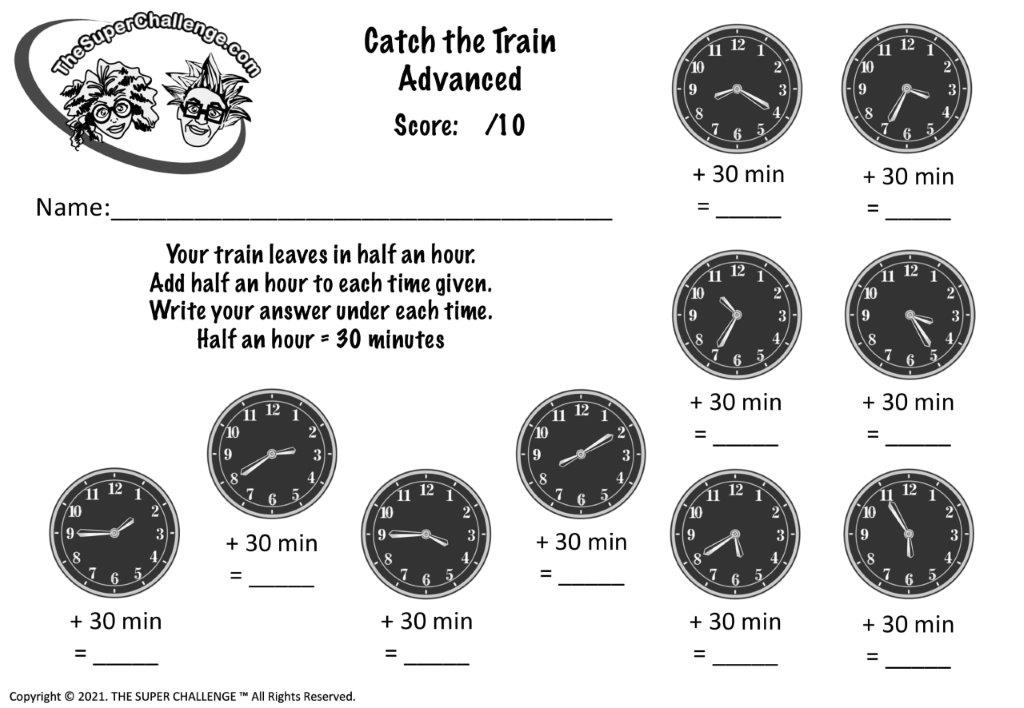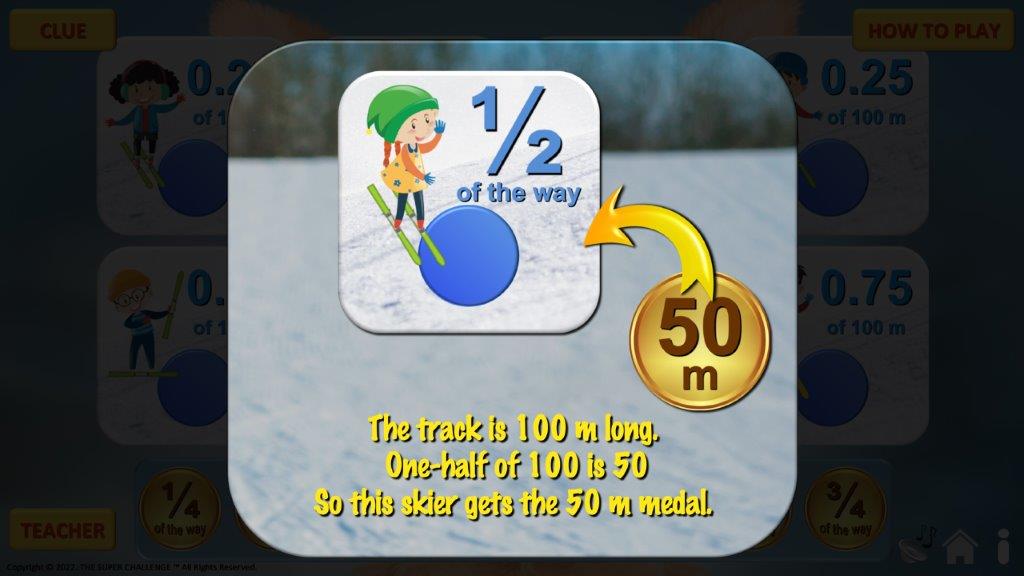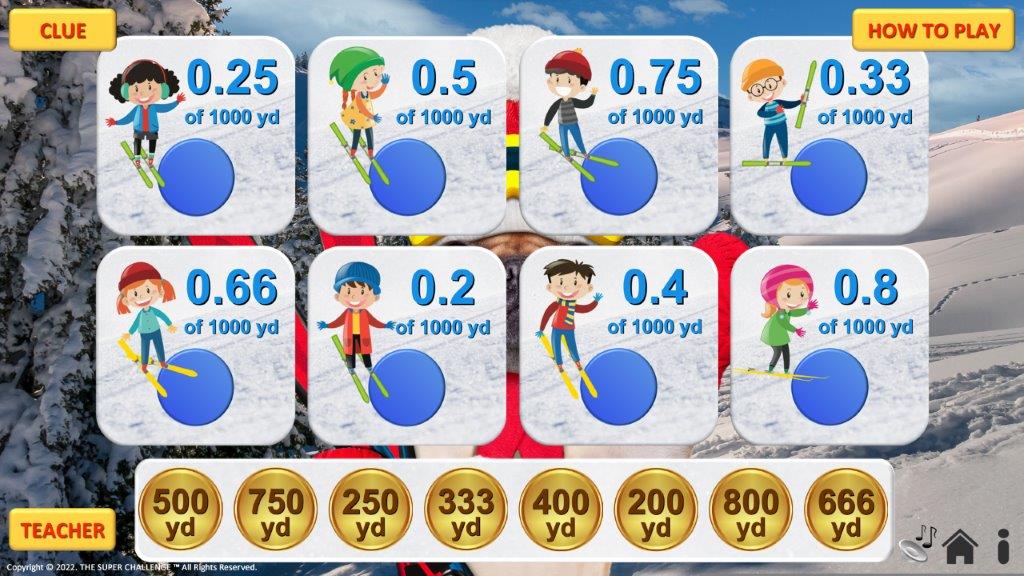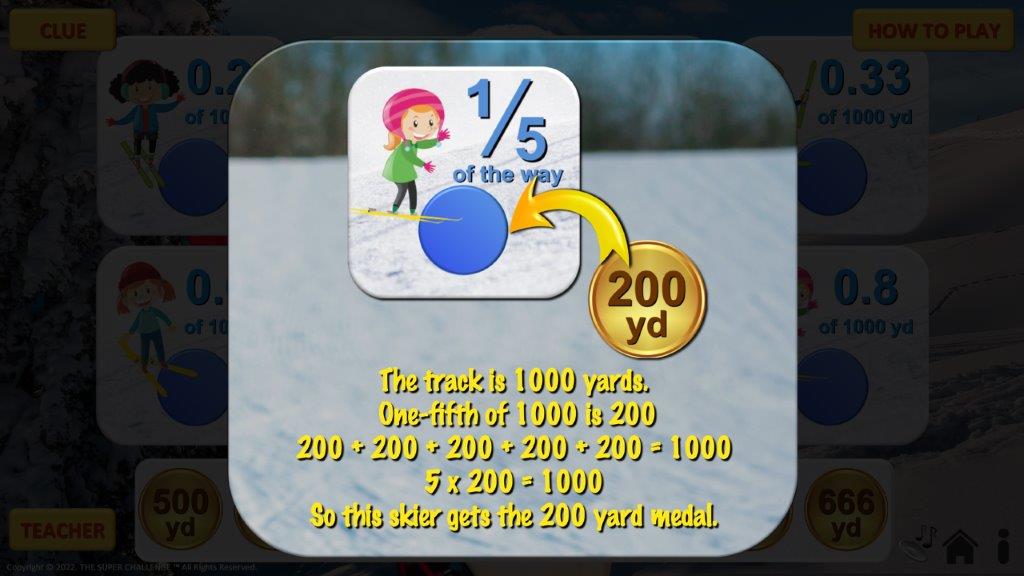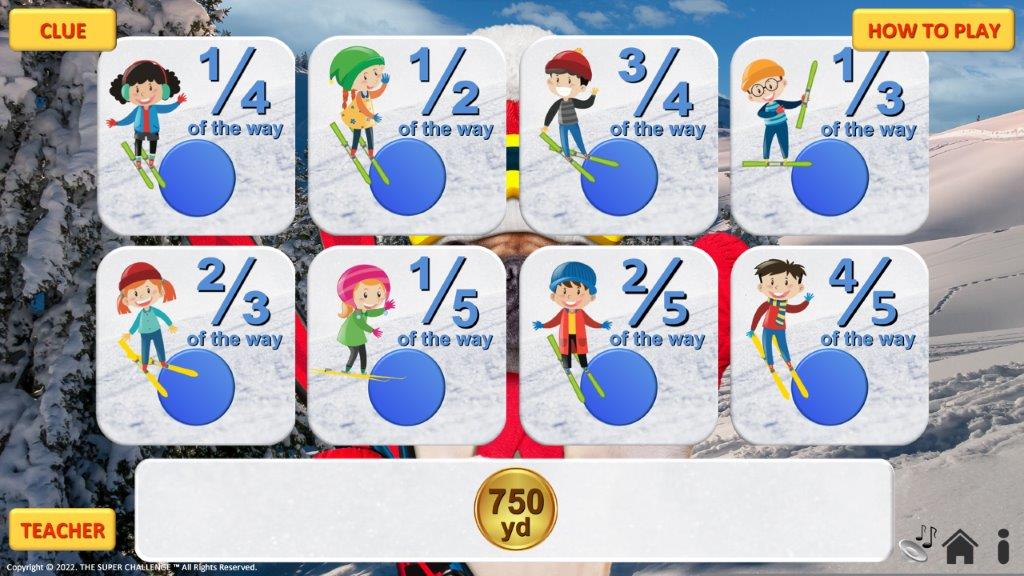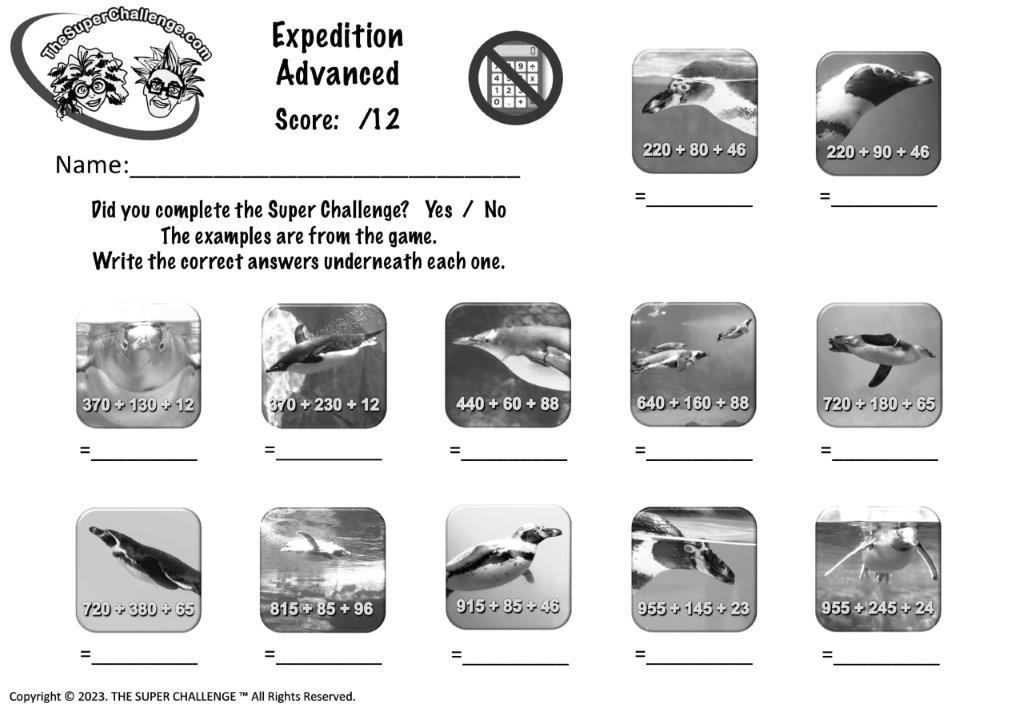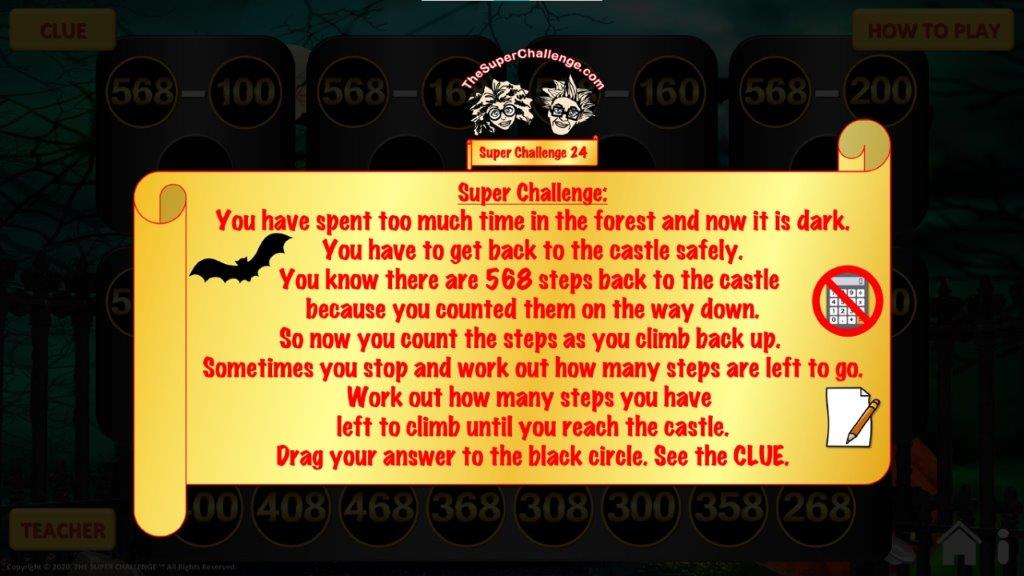YOUR SUPER CHALLENGE:
Your challenge is to complete any 5 games from YOUR grade level. You may do any combination of Mid-level or Advanced level games as long as they are of YOUR grade. A game is only completed when you finish all the questions in the game. You may try some games first to see which ones you would like to play. For games that have different versions, (Standard/Advanced, Money, Metric/Imperial etc), you only need to complete one of the versions. If you do other versions of the same game, it is still counted as only one game.
If you shut the game down, you will have to play from the start again. But if you write down your answers on the worksheet as you play, you can catch up to where you left the game. (The worksheet is optional.)
Once you have fully finished 5 different games, you have completed your challenge and may download your Certificate of Congratulations! But don’t stop there, challenge YOURSELF to see how many more games you can complete!
PARENTS & TUTORS:
The “Advanced Level” games are set at a level students aim to be at by the END of their school year. Also, games are not designed to be played on Safari browsers and may not load. All games may be played on PC’s & laptops; however, some may also be played on tablets, see the listing under each game name.
Warning: Games are not designed to be played using the Safari browsers.
Games should only be played using a web browser such as Chrome, Firefox or Microsoft Edge.
Please open this website using one of these browsers.
It is also advised you have the latest version of the Chrome, Firefox or Microsoft Edge web browsers.
Grade 4 – 5 Explained

Right Angle Ollie
GAME PLAYS ON: PC & LAPTOP ONLY
Right Angle Ollie - Game Description
Ages: 9 – 10 years old
Suits: Grade 4 students in Australia, Fourth Grade students in the U.S.A. & Canada and Year 5 students in England.
Teaching students how to read angles.
This game teaches students to compare angles and classify them as equal to; greater than; or less than a right angle. It is lots of fun and filled with positive words building student confidence in mathematics.
Set at a skateboard park, it is a familiar and practical way to present the concept to them. The game is filled with humorous sound effects. It is very engaging and a good way for teachers to gauge how well a student grasps the concept of angles. It is designed to suit the Mathematics Curriculums of Australia, Canada, England and the U.S.A.
Teacher References:
(ACMMG089) – Compare angles and classify them as equal to; greater than; or less than a right angle.
Ref: Australian Curriculum Mathematics.
How To Play:
You are at a skateboard park. Everyone is trying to do a new trick called a “right angle ollie”. Only one skater can do it perfectly! Who is it? Choose one of the skateboarders and click on them. Only one of the four answers given matches the picture. Choose your answer and drag it to the skateboarder! No guessing! You must get the answer correct on your first or second try, otherwise the GAME STARTS AGAIN! Can you find the skateboarder who does a “right angle ollie”?
Right Angle Ollie - Learning Outcomes

Right Angle Ollie - Worksheet
The Boss – Standard
GAME PLAYS ON: PC & LAPTOP ONLY
The Boss - Standard - Game Description
Ages: 9 – 10 years old
Suits: Grade 4 students in Australia, Fourth Grade students in the U.S.A. & Canada and Year 5 students in England.
Finding unknown quantities in number sentences involving addition and subtraction.
This game helps students with addition and subtraction. It is very challenging but engaging and lots of fun.
Students must solve a practical number sentence puzzle. They are presented with number sentences without the symbols “+”, “-” and “=”, making it less confronting and easy to understand. It is and a good way for teachers to gauge how well a student grasps addition and subtraction in number sentences. It is designed to suit the Mathematics Curriculums of Australia, Canada, England, and the U.S.A.
Teacher References:
(ACNA083): Find unknown quantities in number sentences involving addition and subtraction and identify equivalent number sentences involving addition and subtraction.
Ref: Australian Curriculum Mathematics.
How To Play:
You are the boss of big company and pay your 5 staff $150 each. Put money in to make each column add up to $150. (A column for each person.) Money must go in order, from LARGEST to SMALLEST amounts. See the CLUE. Only after you have completed ALL columns, click to see if you are correct. If any columns are incorrect, the game starts again! It’s tricky, are you ready for the challenge?
The Boss - Standard - Learning Outcomes

The Boss - Standard - Worksheet
The Boss – Advanced
GAME PLAYS ON: PC & LAPTOP ONLY
The Boss - Advanced - Game Description
Ages: 9 – 10 years old
Suits: Grade 4 students in Australia, Fourth Grade students in the U.S.A. & Canada and Year 5 students in England.
Finding unknown quantities in number sentences involving addition and subtraction.
This game helps students with more complex addition and subtraction. The game is the more challenging of the two ”Boss” games but is engaging and lots of fun.
Students must solve a practical number sentence puzzle. They are presented with number sentences without the symbols “+”, “-” and “=”, making it less confronting and easy to understand. It is and a good way for teachers to gauge how well a student grasps addition and subtraction in number sentences. It is designed to suit the Mathematics Curriculums of Australia, Canada, England and the U.S.A.
Teacher References:
(ACMNA083): Find unknown quantities in number sentences involving addition and subtraction and identify equivalent number sentences involving addition and subtraction.
Ref: Australian Curriculum Mathematics.
How To Play:
You have traveled in time to the future! You own a huge company and you to pay your 5 staff $600 each. Put money in to make each column add up to $600. Money must go in order, from LARGEST to SMALLEST amounts. If any columns are incorrect, the game starts again! You may use a pen and paper but no calculator! It’s tricky, are you ready for the challenge?
The Boss - Advanced - Learning Outcomes

The Boss - Advanced - Worksheet
Gumballs
GAME PLAYS ON: PC, LAPTOP & TABLET
Gumballs - Game Description
Ages: 9 – 10 years old
Suits: Grade 4 students in Australia, Fourth Grade students in the U.S.A. & Canada and Year 5 students in England.
Identifying and describing possible outcomes in chance experiments.
This game helps students understand “chance” and how to identify and describe possible outcomes. Students are asked to identify outcomes of events. They are asked to use everyday language such as “most likely”, “equally likely” & “least likely”.
Using gumballs in jars as examples, it makes chance very easy to understand and it is a very effective way for students to learn to describe outcomes. Fun to play and very engaging, it is designed to suit the Mathematics Curriculums of Australia, Canada, England and the U.S.A.
Teacher References:
(ACMSP092): Describe possible everyday events and order their chances of occurring, using lists of events familiar to students and ordering them from ‘least likely’ to ‘most likely’ to occur.
Ref: Australian Curriculum Mathematics.
How To Play:
If you took a gumball from one of the jars, what colour / color is it likely to be? Choose one of the answers in the blue rectangle. Choose a jar you think it matches. Then drag the answer to the blue circle under the jar. Once you have done them all, a new challenge will appear? Are you ready for a challenge?
Gumballs - Learning Outcomes

Gumballs - Worksheet
Charity Run – Dollars
GAME PLAYS ON: PC, LAPTOP & TABLET
Charity Run - Dollars - Game Description
Ages: 9 – 10 years old
Suits: Grade 4 students in Australia, Fourth Grade students in the U.S.A. & Canada.
Understanding the connection between multiplication and division where there is no remainder.
This game helps fourth grade students to understand and become proficient at division. It is a very good introduction to division as it is demonstrated in a simple way that is familiar to the age group.
Using examples of sponsorship forms from a school fun run, students must divide the total amount collected by the number of laps that were run. The challenge is to calculate the amount sponsored per lap.
It is full of positive fun sounds and voice-overs making it a very engaging game to play. The game is designed to suit the Mathematics Curriculums of Australia, Canada & the U.S.A.
Teacher References:
(ACMNA075): Recall multiplication facts up to 10 × 10 and related division facts. Using known multiplication facts to calculate related division facts.
(ACMNA076): Develop efficient mental and written strategies for multiplication and for division where there is no remainder. Connecting division to multiplication when there is no remainder.
Ref: Australian Curriculum Mathematics.
How To Play:
Your class is doing a charity fun run. Everyone is sponsored at different amounts per lap. Your challenge is to find out how much they were sponsored per lap. First you must find a way to work out how much money per lap each student was sponsored! Once you work it out, then match up the amount of money per lap to each student. Drag your answer to the yellow circle. But no guessing!
Charity Run - Dollars - Learning Outcomes

Charity Run - Dollars - Worksheet
Charity Run – Pounds
GAME PLAYS ON: PC, LAPTOP & TABLET
Charity Run - Pounds - Game Description
Ages: 9 – 10 years old
Suits: Year 5 students in England.
Understanding the connection between multiplication and division where there is no remainder.
This game helps students to understand and become proficient at division. It is a very good introduction to division as it is demonstrated in a simple way that is familiar to the age group.
Using examples of sponsorship forms from a school fun run, students must divide the total amount collected by the number of laps that were run. The challenge is to calculate the amount sponsored per lap.
It is full of positive fun sounds and voice-overs making it a very engaging game to play. The game is designed to suit the Mathematics Curriculum of England.
Teacher References:
(ACNA075): Recall multiplication facts up to 10 × 10 and related division facts. Using known multiplication facts to calculate related division facts.
(ACMNA076): Develop efficient mental and written strategies for multiplication and for division where there is no remainder. Connecting division to multiplication when there is no remainder.
Ref: Australian Curriculum Mathematics.
How To Play:
Your class is doing a charity fun run. Everyone is sponsored at different amounts per lap. Your challenge is to find out how much they were sponsored per lap. First you must find a way to work out how much money per lap each student was sponsored! Once you work it out, then match up the amount of money per lap to each student. Drag your answer to the yellow circle. But no guessing! It’s a challenge but you can do it!
Charity Run - Pounds - Learning Outcomes

Charity Run - Pounds - Worksheet
Two Squares
GAME PLAYS ON: PC, LAPTOP & TABLET
Two Squares - Game Description
Ages: 9 – 10 years old
Suits: Grade 4 students in Australia, Fourth Grade students in the U.S.A. & Canada and Year 5 students in England.
Working with two-dimensional shapes to form a composite shape. Comparing shapes to become familiar with the concept of Area.
This is a fun and challenging game to play. Students must use common shapes, (triangles, squares and a parallelogram) to complete a composite shape. Students must build a large square then 2 smaller squares. The challenge is then to calculate the area of the parallelogram piece.
It is very engaging and a good way for students to become familiar with area and problem solving. The game is designed to suit the Mathematics Curriculums of Australia, Canada, England, and the U.S.A.
Teacher References:
(ACMMG087): Compare the areas of regular and irregular shapes by informal means.
(ACMMG088): Compare and describe two-dimensional shapes that result from combining and splitting common shapes. Identifying common two-dimensional shapes that are part of a composite shape by re-creating it from these shapes.
Ref: Australian Curriculum Mathematics.
How To Play:
A square will appear from the clouds. Use the shapes to fill in the square. Then the square will divide into two equal sized squares. Use the shapes to fill those squares also. You may DRAG the shapes to move them. Then you can FLIP or TURN each one to fit. Challenge: If all the seven pieces together have a TOTAL AREA of 160 units, then what is the AREA of the PARALLELOGRAM piece? (See the worksheet.)
Two Squares - Learning Outcomes
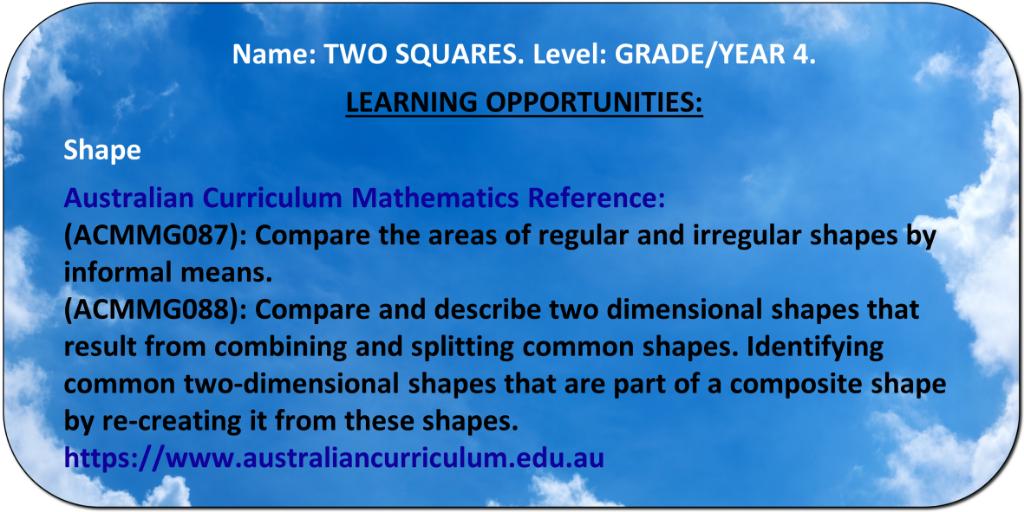
Two Squares - Worksheet
Number Patterns
GAME PLAYS ON: PC, LAPTOP & TABLET
Number Patterns - Game Description
Ages: 9 – 10 years old
Suits: Grade 4 students in Australia, Fourth Grade students in the U.S.A. & Canada and Year 5 students in England.
Identifying number patterns.
This game is designed to helps students understand number patterns. Students are given 4 number pattern puzzles ranging from easiest to most challenging. They must identify the missing numbers in each number pattern. To solve each number pattern puzzle student must use addition and multiplication. Students become absorbed in trying to find the solution. For this reason, the game becomes a good arithmetic exercise.
Fun to play and very engaging, it is designed to suit the Mathematics Curriculums of Australia, Canada, England and the U.S.A.
Teacher References:
(ACMNA081): Explore and describe number patterns resulting from performing multiplication. Identifying examples of number patterns in everyday life.
Ref: Australian Curriculum Mathematics.
How To Play:
Numbers come in patterns, all around the world! Your challenge is to find missing numbers in patterns. First you must put numbers in order from smallest to largest. Do not put numbers onto the question marks! Then click the blue box to see if you are correct so far. Next can you work out what the missing numbers are? Drag the correct answer to the question mark. Take your time. If you are wrong, the game restarts!
Number Patterns - Learning Outcomes

Number Patterns - Worksheet
Astronaut – Standard
GAME PLAYS ON: PC & LAPTOP ONLY
Astronaut - Standard - Game Description
Ages: 9 – 10 years old
Suits: Grade 4 students in Australia, Fourth Grade students in the U.S.A. & Canada and Year 5 students in England.
Converting between units of time, hours to minutes to seconds.
This game helps students investigate the relationship between units of time. Students learn to identifying and use the correct operation for converting units of time. Converting between seconds, minutes, and hours. Identifying there are 60 minutes in an hour and 60 seconds in a minute and how to convert between them.
Set in outer space with great sound effects, it is an exciting and very engaging way for students to learn time conversion. This is particularly important as converting units of time is often a difficult concept for students of this age to grasp. This is the first game of two, time conversion games. The more challenging game is called The Sun. The game is designed to suit the Mathematics Curriculums of Australia, Canada, England, and the U.S.A.
Teacher References:
(ACMMG085): Convert between units of time. Identifying and using the correct operation for converting units of time, i.e., identifying there are 60 minutes in an hour and 60 seconds in a minute and how to convert between them.
Ref: Australian Curriculum Mathematics.
How To Play:
You are an astronaut, and you are calculating how much oxygen you have left. You need to know how to add up time. You must get it right; your life depends on it! Click on any of the clocks. Only one of the four times you are given is correct. Which one is it? Choose the correct answer, see the CLUE. Then drag your answer to the clock above. Get it right or you may run out of oxygen!
Astronaut - Standard - Learning Outcomes

Astronaut - Standard - Worksheet
Astronaut – Advanced
GAME PLAYS ON: PC & LAPTOP ONLY
Astronaut - Advanced - Game Description
Ages: 9 – 10 years old
Suits: Grade 4 students in Australia, Fourth Grade students in the U.S.A. & Canada and Year 5 students in England.
Understanding time conversion. This game has more challenging conversions of seconds to minutes & minutes to hours.
This game is designed to help students convert between units of time. This is the second game of two, time conversion games. It is the more challenging game, and it is a good gauge for teachers to see how well a student grasps this concept. Students learn to identifying and use the correct operation for converting units of time by converting back and forth between seconds, minutes, and hours.
Set in outer space with great sound effects, it is an exciting and very engaging way for students to learn time conversion. The game is designed to suit the Mathematics Curriculums of Australia, Canada, England, and the U.S.A.
Teacher References:
(ACMMG085): Convert between units of time. Identifying and using the correct operation for converting units of time, i.e., identifying there are 60 minutes in an hour and 60 seconds in a minute and how to convert between them.
Ref: Australian Curriculum Mathematics.
How To Play:
You are an astronaut and the sun’s rays are about to burn you. You must get back to the spacecraft. How much time do you have left? Click on any of the clocks. Then add up how much time you have left. Only one of the four times you are given is correct. Which one is it? Choose the correct answer, see the CLUE. Then drag your answer to the clock above. Are you ready for the challenge?
Astronaut - Advanced - Learning Outcomes

Astronaut - Advanced - Worksheet
Lunch Orders – Australia
GAME PLAYS ON: PC & LAPTOP ONLY
Lunch Orders - Australia - Game Description
Ages: 9 – 10 years old
Suits: Grade 4 students in Australia.
Calculating the cost of purchases and change to the nearest five cents without a calculator.
This game helps students to solve problems involving the calculation of purchases and the correct change. The game has a double learning benefit as students must not use a calculator. It is a good opportunity for students to develop addition and subtraction skills. Students are asked calculate cost and change for school lunch orders. A familiar and practical problem for them.
The game is lots of fun to play and filled with humorous sound effects. It is a very engaging game and a good gauge for teachers to see how well a student understands problem solving and money values. It is designed to suit the Mathematics Curriculums of Australia, Canada, England, and the U.S.A.
Teacher References:
(ACMNA080): Solve problems involving purchases and the calculation of change to the nearest five cents without digital technologies.
Ref: Australian Curriculum Mathematics.
How To Play:
It’s your turn to get the lunch orders. On your way back to class, you notice all the change has fallen out of the bags! You need to put the right change back into each bag. Click on any of the lunch orders. Choose the correct amount of change. Then drag your answer to the lunch order above. Are you ready for the challenge?
Lunch Orders - Australia - Learning Outcomes

Lunch Orders - Australia - Worksheet
Lunch Orders – Canada
GAME PLAYS ON: PC & LAPTOP ONLY
Lunch Orders - Canada - Game Description
Ages: 9 – 10 years old
Suits: Fourth Grade students Canada.
Calculating the cost of purchases and change to the nearest five cents without a calculator.
This game helps students to solve problems involving the calculation of purchases and the correct change. The game has a double learning benefit as students must not use a calculator. It is a good opportunity for students to develop addition and subtraction skills. Students are asked calculate cost and change for school lunch orders. A familiar and practical problem for them.
The game is lots of fun to play and filled with humorous sound effects. It is a very engaging game and a good gauge for teachers to see how well a student understands problem solving and money values. It is designed to suit the Mathematics Curriculums of Australia, Canada, England, and the U.S.A.
Teacher References:
(ACMNA080): Solve problems involving purchases and the calculation of change to the nearest five cents without digital technologies.
Ref: Australian Curriculum Mathematics.
How To Play:
It’s your turn to get the lunch orders. On your way back to class, you notice all the change has fallen out of the bags! You need to put the right change back into each bag. Click on any of the lunch orders. Choose the correct amount of change. Then drag your answer to the lunch order above. Are you ready for the challenge?
Lunch Orders - Canada - Learning Outcomes

Lunch Orders - Canada - Worksheet
Lunch Orders – England
GAME PLAYS ON: PC & LAPTOP ONLY
Lunch Orders - England - Game Description
Ages: 9 – 10 years old
Suits: Year 5 students England.
Calculating the cost of purchases and change to the nearest five pence without a calculator.
This game helps students to solve problems involving the calculation of purchases and the correct change. The game has a double learning benefit as students must not use a calculator. It is a good opportunity for students to develop addition and subtraction skills. Students are asked calculate cost and change for school lunch orders. A familiar and practical problem for them.
The game is lots of fun to play and filled with humorous sound effects. It is a very engaging game and a good gauge for teachers to see how well a student understands problem solving and money values. It is designed to suit the Mathematics Curriculums of Australia, Canada, England, and the U.S.A.
Teacher References:
(ACMNA080): Solve problems involving purchases and the calculation of change to the nearest five (pence) without digital technologies.
Ref: Australian Curriculum Mathematics.
How To Play:
It’s your turn to get the lunch orders. On your way back to class, you notice all the change has fallen out of the bags! You need to put the right change back into each bag. Click on any of the lunch orders. Choose the correct amount of change. Then drag your answer to the lunch order above. Are you ready for the challenge?
Lunch Orders - England - Learning Outcomes

Lunch Orders - England - Worksheet
Lunch Orders – USA
GAME PLAYS ON: PC & LAPTOP ONLY
Lunch Orders - USA - Game Description
Ages: 9 – 10 years old
Suits: Fourth Grade students in the U.S.A.
Calculating the cost of purchases and change to the nearest five cents without a calculator.
This game helps students to solve problems involving the calculation of purchases and the correct change. The game has a double learning benefit as students must not use a calculator. It is a good opportunity for students to develop addition and subtraction skills. Students are asked calculate cost and change for school lunch orders. A familiar and practical problem for them.
The game is lots of fun to play and filled with humorous sound effects. It is a very engaging game and a good gauge for teachers to see how well a student understands problem solving and money values. It is designed to suit the Mathematics Curriculums of Australia, Canada, England, and the U.S.A.
Teacher References:
(ACMNA080): Solve problems involving purchases and the calculation of change to the nearest five cents without digital technologies.
Ref: Australian Curriculum Mathematics.
How To Play:
It’s your turn to get the lunch orders. On your way back to class, you notice all the change has fallen out of the bags! You need to put the right change back into each bag. Click on any of the lunch orders. Choose the correct amount of change. Then drag your answer to the lunch order above. Are you ready for the challenge?
Lunch Orders - USA - Learning Outcomes

Lunch Orders - USA - Worksheet
Alien City
GAME PLAYS ON: PC, LAPTOP & TABLET
Alien City - Game Description
Ages: 9 – 10 years old
Suits: Grade 4 students in Australia, Fourth Grade students in the U.S.A. & Canada and Year 5 students in England.
Introducing the Cartesian coordinate system and ordered pairs in preparation for reading maps and interpreting graphs.
This game helps students learn how to read a grid map and to interpret a graph. It introduces the Cartesian coordinate system and ordered pairs.
Set on an alien planet with great sound effects, it is an exciting and very engaging way for students to learn the Cartesian coordinate system. It also teaches students how to read ordered pairs, an important concept to learn for students of this age.
The game is designed to suit the Mathematics Curriculums of Australia, Canada, England, and the U.S.A.
Teacher References:
(ACMMG090): Interpret information contained in basic maps.
Focusing on the Cartesian Coordinate System and Ordered Pairs.
Ref: Australian Curriculum Mathematics.
How To Play:
You are in an alien city on another planet. Can you read the city map? If you can read a grid, you can read a city map. As pieces appear, put them onto their correct positions on the grid. Do this until you have done them all! Make sure you drag each one carefully. Are you ready for the challenge?
Alien City - Learning Outcomes

Alien City - Worksheet
Balance – Metric A
GAME PLAYS ON: PC & LAPTOP ONLY
Balance - Metric A - Game Description
Ages: 9 – 10 years old
Suits: Grade 4 students in Australia & Canada.
Identifying and converting between familiar metric units of mass, i.e., kilograms and grams.
Helping students to investigate the relationship between metric units of mass. Students learn to convert between kilograms and grams. This game has a double learning benefit as it also asks students to apply place-value to partition, rearrange and regroup numbers.
The game is set with frogs in a pond with the sounds of nature and is a very calming game to play. It is filled with positive and encouraging voice overs to build student confidence in mathematics. It is the first game of two, units of mass conversion games. The more challenging game is called Balance – Metric B. The game is designed to suit the Mathematics Curriculums of Australia & Canada.
Teacher References:
(ACMNA073): Apply place-value to partition, rearrange and regroup numbers.
(ACMMG061): Order and compare objects using familiar metric units of mass. Note: This game has a more challenging version called BALANCE – METRIC B.
Ref: Australian Curriculum Mathematics.
How To Play:
You work at the zoo and your job is to feed the frogs. Make sure you give them the correct amount. Click on a TOTAL WEIGHT. Choose the correct answer, (see the CLUE). Then drag your answer to the total above. It’s a challenge but you can do it!
Balance - Metric A - Learning Outcomes

Balance - Metric A - Worksheet
Balance – Metric B
GAME PLAYS ON: PC & LAPTOP ONLY
Balance - Metric B - Game Description
Ages: 9 – 10 years old
Suits: Grade 4 students in Australia & Canada.
Advanced conversion between familiar metric units of mass, i.e., kilograms and grams.
Helping students to investigate the relationship between metric units of mass. It is the second and more challenging game of 2, units of mass conversion games. The simpler game is called Balance – Metric A. In both games, students learn to convert between kilograms and grams. This game has a double learning benefit as it also asks students to apply place-value to partition, rearrange and regroup numbers.
The game is set with frogs in a pond with the sounds of nature and is a very calming game to play. It is filled with positive and encouraging voice overs to build student confidence in mathematics. The game is designed to suit the Mathematics Curriculums of Australia & Canada.
Teacher References:
(ACMNA073): Apply place-value to partition, rearrange and regroup numbers.
(ACMMG061): Order and compare objects using familiar metric units of mass. Note: This game has a less challenging version called BALANCE – METRIC A.
Ref: Australian Curriculum Mathematics.
How To Play:
You work at the zoo and your job is to feed the frogs. Make sure you give them the correct amount. Click on a TOTAL WEIGHT. Choose the correct answer, (see the CLUE). Then drag your answer to the total above. It’s a challenge but you can do it!
Balance - Metric B - Learning Outcomes

Balance - Metric B - Worksheet
Balance – Imperial
GAME PLAYS ON: PC & LAPTOP ONLY
Balance - Imperial - Game Description
Ages: 9 – 10 years old
Suits: Grade 4 students the U.S.A. and Year 5 students in England.
Identifying and converting between familiar units of mass, i.e., pounds and ounces.
Helping students investigate the relationship between units of mass. Students learn to convert between pounds and ounces. This game has a double benefit as it also asks students to count by halves and quarters.
Set with frogs in a pond with the sounds of nature, it is a very calming game to play. It is filled with positive and encouraging voice-overs to build student confidence in mathematics. The game is designed to suit the Mathematics Curriculums of England and the U.S.A.
Teacher References:
(ACMMG061): Order and compare objects using familiar units of mass.
(ACMNA078): Count by quarters and halves.
Ref: AustralianCurriculum Mathematics.
How To Play:
You work at the zoo and your job is to feed the frogs. Make sure you give them the correct amount. Click on a TOTAL WEIGHT. Choose the correct answer, (see the CLUE). Then drag your answer to the total above. It’s a challenge but you can do it!
Balance - Imperial - Learning Outcomes

Balance - Imperial - Worksheet
Area – Metric
GAME PLAYS ON: PC, LAPTOP & TABLET
Area - Metric - Game Description
Ages: 9 – 10 years old
Suits: Grade 4 students in Australia and Fourth Grade students in Canada.
Working with two-dimensional shapes to form a composite shape. Comparing shapes to become familiar with the concepts of area and perimeter and their metric units.
Students use pentominoes of different shapes to cover the floor plan of 2 different sized bedrooms. Then they must calculate the area and perimeter of each room. It introduces students to important concepts such as symmetry, area, and perimeter.
It is very engaging and a good way for students to become familiar with area, perimeter and problem solving. The game is designed to suit the Mathematics Curriculums of Australia and Canada.
Teacher References:
(ACMMG087): Compare the areas of regular shapes by informal means.
(ACMMG290): Compare objects using familiar metric units of area.
Ref: Australian Curriculum Mathematics.
How To Play:
First, a floor plan will appear for you. Use the shapes to fill up each room on the plan. DRAG the shapes to move them. Once you have completed both puzzles, calculate is the AREA of each room. (Use the clues.) Can you find a different way to work out the AREA of each room? Can you work out the AREA of your own bedroom?
Area - Metric - Learning Outcomes

Area - Metric - Worksheet
Area – Imperial
GAME PLAYS ON: PC, LAPTOP & TABLET
Area - Imperial - Game Description
Ages: 9 – 10 years old
Suits: Fourth Grade students in the U.S.A. and year 5 students in England.
Working with two-dimensional shapes to form a composite shape. Comparing shapes to become familiar with the concepts of area and perimeter and their imperial units.
Students use pentominoes of different shapes to cover the floor plan of 2 different sized bedrooms. Then they must calculate the area and perimeter of each room. It introduces students to important concepts such as symmetry, area, and perimeter.
It is very engaging and a good way for students to become familiar with area. perimeter and problem solving. The game is designed to suit the Mathematics Curriculums of the U.S.A. and England.
Teacher References:
(ACMMG087): Compare the areas of regular shapes by informal means.
(ACMMG290): Compare objects using familiar units of area.
Ref: Australian Curriculum Mathematics.
How To Play:
First, a floor plan will appear for you. Use the shapes to fill up each room on the plan. DRAG the shapes to move them. Once you have completed both puzzles, calculate is the AREA of each room. (Use the clues.) Can you find a different way to work out the AREA of each room? Can you work out the AREA of your own bedroom?
(See the worksheet.)
Area - Imperial - Learning Outcomes

Area - Imperial - Worksheet
Stickers – 1
GAME PLAYS ON: PC & LAPTOP ONLY
Stickers – 1 - Game Description
Ages: 9 – 10 years old
Suits: Grade 4 students in Australia, Fourth Grade students in the U.S.A. & Canada and Year 5 students in England.
Understanding multiplication facts up to 10 × 10 and related division facts.
This game helps students understand multiplication and division. Students must recall their tables up to 10 x 10 and solve problems without a calculator. The game is lots of fun and filled with positive words building student confidence in mathematics.
Designed around sharing stickers with friends, it is a familiar and practical way to present the concept to them. The game is filled with humorous sound effects. It is very engaging and a good way for teachers to gauge how well a student grasps the concepts of multiplication and division. It is designed to suit the Mathematics Curriculums of Australia, Canada, England, and the U.S.A.
Teacher References:
(ACMNA075): Recall multiplication facts up to 10 × 10 and related division facts.
(ACMNA076): Develop efficient mental and written strategies for multiplication and for division where there is no remainder.
Ref: Australian Curriculum Mathematics.
How To Play:
Your teacher is giving out stickers to good students. Can you help choose the correct number of stickers needed? Click on one of the groups. Work out the TOTAL number stickers they need. If you use a pencil and paper, it will help! There must be no stickers left over! (See the CLUE.) Students will share stickers evenly. You must complete all the groups to finish the game!
Stickers – 1 - Learning Outcomes
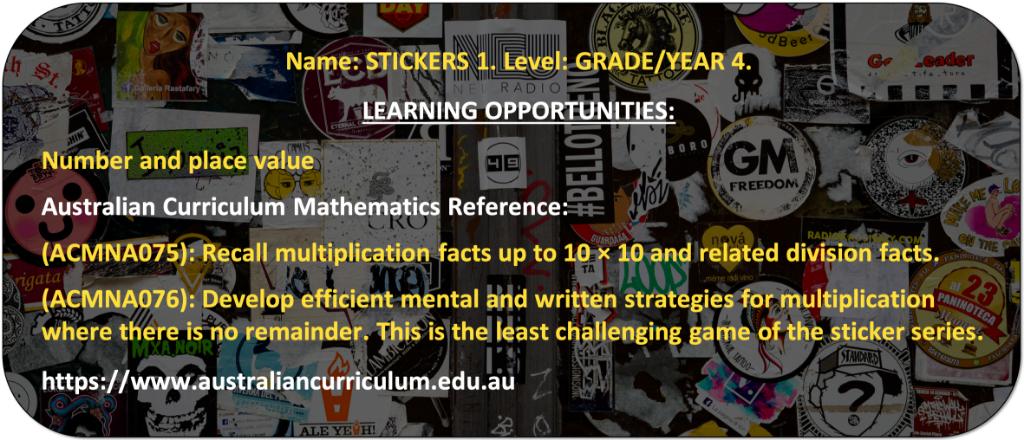
Stickers – 1 - Worksheet
Stickers – 2
GAME PLAYS ON: PC & LAPTOP ONLY
Stickers – 2 - Game Description
Ages: 9 – 10 years old
Suits: Grade 4 students in Australia, Fourth Grade students in the U.S.A. & Canada and Year 5 students in England.
Understanding multiplication facts up to 10 × 10 and related division facts.
This game is slightly more challenging than Stickers 1. Students must recall some of the more challenging tables up to 10 x 10 and solve problems without a calculator. The game is lots of fun and filled with positive words building student confidence in mathematics.
Designed around sharing stickers with friends, it is a familiar and practical way to present the concept to them. The game is filled with humorous sound effects. It is very engaging and a good way for teachers to gauge how well a student grasps the concepts of multiplication and division. It is designed to suit the Mathematics Curriculums of Australia, Canada, England, and the U.S.A.
Teacher References:
(ACMNA075): Recall multiplication facts up to 10 × 10 and related division facts.
(ACMNA076): Develop efficient mental and written strategies for multiplication and for division where there is no remainder.
Ref: Australian Curriculum Mathematics.
How To Play:
Students are given more stickers to share evenly. Can you help choose the correct sheets of stickers? Click on one of the groups. Work out the TOTAL number stickers they need. If you use a pencil and paper, it will help! There must be no stickers left over! (See the CLUE.) Students will share stickers evenly. You must complete all the groups to finish the game!
Stickers – 2 - Learning Outcomes

Stickers – 2 - Worksheet
Stickers – 3
GAME PLAYS ON: PC & LAPTOP ONLY
Stickers - 3 - Game Description
Ages: 9 – 10 years old
Suits: Grade 4 students in Australia, Fourth Grade students in the U.S.A. & Canada and Year 5 students in England.
Understanding multiplication facts up to 12 × 12 and beyond including related division facts.
This game is the more challenging of the Sticker game series. Students must go beyond tables of 12 x 12 and solve problems without a calculator. With the help of a tutor or teacher, the game is not beyond most students’ capabilities, particularly if it is played at the end of the school year.
Designed around sharing stickers with friends, it is a familiar and practical way to present the concept to them. The game is filled with humorous sound effects. It is very engaging and a good way for teachers to gauge how well a student grasps the concepts of multiplication and division. It is designed to suit the Mathematics Curriculums of Australia, Canada, England, and the U.S.A.
Teacher References:
(ACMNA075): Recall multiplication facts up to 10 × 10 (and beyond), and related division facts.
(ACMNA076): Develop efficient mental and written strategies for multiplication and for division where there is no remainder.
Ref: Australian Curriculum Mathematics.
How To Play:
More stickers are given out by teachers. Click on one of the groups. Work out the TOTAL number stickers they need. Can you help choose the correct sheets of stickers? If you use a pencil and paper, it will help! There must be no stickers left over! (See the CLUE.) Students will share stickers evenly. You must complete all the groups to finish the game!
Stickers - 3 - Learning Outcomes
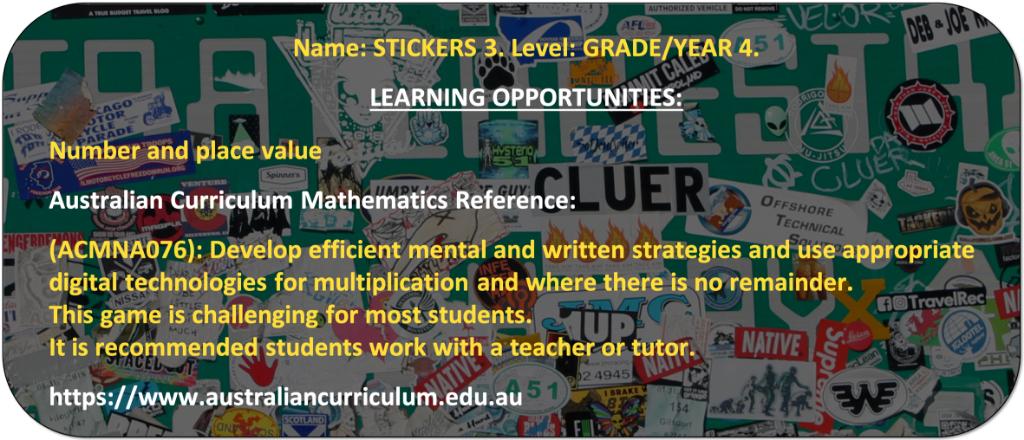
Stickers - 3 - Worksheet
The Circus – Australia
GAME PLAYS ON: PC & LAPTOP ONLY
The Circus - Australia - Game Description
Ages: 9 – 10 years old
Suits: Grade 4 students in Australia.
Solve problems involving purchases and the calculation of change with a calculator. This game uses the Australian currency.
Helping students solve problems involving the calculation of purchases and the correct change using a calculator. Students should also play the other circus games in this series that involve the currencies of Canada, England, and the U.S.A. The second part of this learning process is for students to learn about and to carry out calculations in other currencies.
The game is set at the circus with trapeze artists and is exciting to play. It is filled with circus sound effects and positive voice-overs to build confidence in mathematics. It is a very engaging game and a good way for teachers to introduce currencies of other countries. This game is designed to suit the Mathematics Curriculums of Australia, Canada, England, and the U.S.A.
Teacher References:
(ACMNA080): Solve problems involving purchases and the calculation of change, with and without digital technologies. Carrying out calculations in another currency as well as in dollars and cents.
Ref: Australian Curriculum Mathematics.
How To Play:
You are at the circus and your friends want ice cream. Each person gives you money to buy them. Make sure everyone gets the right amount of change. Click on one of the sets of ice creams. Choose the correct amount of change. You may use a calculator, to check your answer. Then drag your answer to the ice creams above. Are you ready for this challenge?
The Circus - Australia - Learning Outcomes

The Circus - Australia - Worksheet
The Circus – Canada
GAME PLAYS ON: PC & LAPTOP ONLY
The Circus - Canada - Game Description
Ages: 9 – 10 years old
Suits: Fourth Grade students in Canada.
Solve problems involving purchases and the calculation of change with a calculator. This game uses the Canadian currency.
Helping students solve problems involving the calculation of purchases and the correct change using a calculator. Students should also play the other circus games in this series that involve the currencies of Australia, England, and the U.S.A. The second part of this learning process is for students to learn about and to carry out calculations in other currencies.
The game is set at the circus with trapeze artists and is exciting to play. It is filled with circus sound effects and positive voice-overs to build confidence in mathematics. It is a very engaging game and a good way for teaches to introduce currencies of other countries. This game is designed to suit the Mathematics Curriculums of Australia, Canada, England, and the U.S.A.
Teacher References:
(ACMNA080): Solve problems involving purchases and the calculation of change, with and without digital technologies. Carrying out calculations in another currency as well as in dollars and cents.
Ref: Australian Curriculum Mathematics.
How To Play:
You are at the circus and your friends want ice cream. Each person gives you money to buy them. Make sure everyone gets the right amount of change. Click on one of the sets of ice creams. Choose the correct amount of change. You may use a calculator, to check your answer. Then drag your answer to the ice creams above. Are you ready for this challenge?
The Circus - Canada - Learning Outcomes

The Circus - Canada - Worksheet
The Circus – England
GAME PLAYS ON: PC & LAPTOP ONLY
The Circus - England - Game Description
Ages: 9 – 10 years old
Suits: Year 5 students in England.
Solve problems involving purchases and the calculation of change with a calculator. This game uses British currency.
Helping Year 5 students to solve problems involving the calculation of purchases and the correct change using a calculator. Students should also play the other circus games in this series that involve the currencies of Australia, Canada, and the U.S.A. The second part of this learning process is for students to learn about and to carry out calculations in other currencies.
The game is set at the circus with trapeze artists and is exciting to play. It is filled with circus sound effects and positive voice-overs to build confidence in mathematics. It is a very engaging game and a good way for teachers to introduce currencies of other countries. This game is designed to suit the Mathematics Curriculums of Australia, Canada, England, and the U.S.A.
Teacher References:
(ACMNA080): Solve problems involving purchases and the calculation of change, with and without digital technologies.
Ref: Australian Curriculum Mathematics.
How To Play:
You are at the circus and your friends want ice cream. Each person gives you money to buy them. Make sure everyone gets the right amount of change. Click on one of the sets of ice creams. Choose the correct amount of change. You may use a calculator, to check your answer. Then drag your answer to the ice creams above. Are you ready for this challenge?
The Circus - England - Learning Outcomes

The Circus - England - Worksheet
The Circus – USA
GAME PLAYS ON: PC & LAPTOP ONLY
The Circus - USA - Game Description
Ages: 9 – 10 years old
Suits: Fourth Grade students in the U.S.A.
Solve problems involving purchases and the calculation of change with a calculator. This game uses the currency of the U.S.A.
Helping students solve problems involving the calculation of purchases and the correct change using a calculator. Students should also play the other circus games in this series that involve the currencies of Australia, Canada, and England. The second part of this learning process is for students to learn about and to carry out calculations in other currencies.
The game is set at the circus with trapeze artists and is exciting to play. It is filled with circus sound effects and positive voice-overs to build confidence in mathematics. It is a very engaging game and a good way for teachers to introduce currencies of other countries. This game is designed to suit the Mathematics Curriculums of Australia, Canada, England, and the U.S.A.
Teacher References:
(ACMNA080): Solve problems involving purchases and the calculation of change, with and without digital technologies. Carrying out calculations in another currency as well as in dollars and cents.
Ref: Australian Curriculum Mathematics.
How To Play:
You are at the circus and your friends want ice cream. Each person gives you money to buy them. Make sure everyone gets the right amount of change. Click on one of the sets of ice creams. Choose the correct amount of change. You may use a calculator, to check your answer. Then drag your answer to the ice creams above. Are you ready for this challenge?
The Circus - USA - Learning Outcomes

The Circus - USA - Worksheet
School Bags – Metric
GAME PLAYS ON: PC, LAPTOP & TABLET
School Bags - Metric - Game Description
Ages: 9 – 10 years old
Suits: Grade 4 students in Australia & Canada as it uses the metric system.
Addition of equivalent fractions including with mixed numerals. Adding quarters, halves, thirds, and fifths.
This game helps students learn how to add fractions. Students must add fractions, including with mixed numerals. It is a very good introduction to addition of fractions as it is demonstrated in a simple way that is familiar to the age group. It uses examples of different weights of the contents of student school bags.
It also has a double benefit as students must add units of mass. The is designed to suit the Mathematics Curriculums of Australia & Canada.
Teacher References:
(ACMNA077): Investigate equivalent fractions used in contexts. Exploring the relationship between families of fractions, (halves, quarters and eighths or thirds and sixths).
(ACMNA078): Count by quarters halves thirds, (and fifths) including with mixed numerals.
Ref: Australian Curriculum Mathematics.
How To Play:
How heavy is your school bag? Do you know? Your teacher has asked everyone in your class to weigh the contents of their schoolbags. You will be given weights of contents to add up. First add the contents up, then choose the correct weight, (see the CLUE). Can you match up the correct answer? Drag your answer to the yellow circle. It’s a challenge but you can do it!
School Bags - Metric - Learning Outcomes

School Bags - Metric - Worksheet
School Bags – Imperial
GAME PLAYS ON: PC, LAPTOP & TABLET
School Bags – Imperial - Game Description
Ages: 9 – 10 years old
Suits: Fourth Grade students in the U.S.A., Year 5 students in England.
Addition of equivalent fractions including with mixed numerals. Adding quarters, halves, thirds, and fifths.
This game helps students learn how to add fractions. Students must add fractions, including with mixed numerals. It is a very good introduction to addition of fractions as it is demonstrated in a simple way that is familiar to the age group. It uses examples of different weights of the contents of student school bags.
It also has a double benefit as students must add units of mass. The game is designed to suit the Mathematics Curriculums of England and the U.S.A.
Teacher References:
(ACMNA077): Investigate equivalent fractions used in contexts. Exploring the relationship between families of fractions, (halves, quarters and eighths or thirds and sixths).
(ACMNA078): Count by quarters halves thirds, (and fifths) including with mixed numerals.
Ref: Australian Curriculum Mathematics.
How To Play:
How heavy is your school bag? Do you know? Your teacher has asked everyone in your class to weigh the contents of their schoolbags. You will be given weights of contents to add up. First add the contents up, then choose the correct weight, (see the CLUE). Can you match up the correct answers? Drag your answer to the yellow circle. It’s a challenge but you can do it!
School Bags – Imperial - Learning Outcomes

School Bags – Imperial - Worksheet
Three to Make Two
GAME PLAYS ON: PC, LAPTOP & TABLET
Three to Make Two - Game Description
Ages: 9 – 10 years old
Suits: Grade 4 students in Australia, Fourth Grade students in the U.S.A. & Canada and Year 5 students in England.
Exploring the relationship between families of fractions (halves, quarters and thirds and sixths).
This game helps students understand equivalent fractions. Students explore the relationship between halves, quarters, thirds, and sixths. The game involves a triangular puzzle that students must solve. It has three parts, with the final part a real challenge.
It is a fun game to play and very engaging. This game is a good gauge for teachers to assess how well a student understands fractions. The game is designed to suit the Mathematics Curriculums of Australia, Canada, England, and the U.S.A.
Teacher References:
(ACMNA077): Investigate equivalent fractions used in contexts. Exploring the relationship between families of fractions (halves, quarters and eighths or thirds and sixths)
(ACMNA078): Count by quarters halves and thirds, including with mixed numerals. Converting mixed numbers to improper fractions and vice versa. Locate and represent these fractions on a number line.
Ref: Australian Curriculum Mathematics.
How To Play:
Place numbers into the circles so every straight line adds up to 2. DRAG each number to move them. Once you have done it, a new challenge will appear! It will be a challenge, but you can do it!
Three to Make Two - Learning Outcomes

Three to Make Two - Worksheet
Catch the Train – Standard
GAME PLAYS ON: PC & LAPTOP ONLY
Catch the Train - Standard - Game Description
Ages: 9 – 10 years old
Suits: Grade 4 students in Australia, Fourth Grade students in the U.S.A. & Canada and Year 5 students in England.
Teaching students how to add half an hour to times given on analogue and digital clocks. Solving simple addition of time problems.
This game helps students to master reading the time. It is a challenging game for most students as they must add half an hour to times given. Time increments in this game are 15 minutes, making it a good easy introduction to adding time. The game is a good gauge of the level of a student’s ability to read time. The game uses both analogue and digital clocks and converting between them.
It is lots of fun and is set around catching a steam train. It is also full of encouraging words to build mathematical confidence and is designed to suit the Mathematics Curriculums of Australia, Canada, England, and the U.S.A.
Teacher References:
(ACMMG085): Convert between units of time. Identifying and using the correct operation for converting units of time.
(ACMMG086): Use “am” and “pm” notation and solve simple time problems.
Ref: Australian Curriculum Mathematics.
How To Play:
You are going for a ride on a steam train! Your train leaves in half an hour. Do you know what time that is? Click on a clock. Add half an hour to the time given. If you get the time wrong, you may miss your train. Can you read time? Let’s find out! It can be tricky. Are you ready for the challenge?
Catch the Train - Standard - Learning Outcomes

Catch the Train - Standard - Worksheet
Catch the Train – Advanced
GAME PLAYS ON: PC & LAPTOP ONLY
Catch the Train - Advanced - Game Description
Ages: 9 – 10 years old
Suits: Grade 4 students in Australia, Fourth Grade students in the U.S.A. & Canada and Year 5 students in England.
Teaching students how to add half an hour to times given on analogue and digital clocks. Solving more complex addition of time problems.
This is the more challenging game of the series. Time increments in this game are 5 minutes, making it a more challenging game. Students must again add half an hour to times given. The game uses both analogue and digital clocks and converting between them.
It is lots of fun and is set around catching a modern speed train. It is also full of encouraging words to build mathematical confidence and is designed to suit the Mathematics Curriculums of Australia, Canada, England, and the U.S.A.
Teacher References:
(ACMMG085): Convert between units of time. Identifying and using the correct operation for converting units of time.
(ACMMG086): Use “am” and “pm” notation and solve simple time problems.
Ref: Australian Curriculum Mathematics.
How To Play:
You are now going for a ride on a speed train! Your train leaves in half an hour. Do you know what time that is? Click on a clock. Add half an hour to the time given. If you get the time wrong, you may miss your train. Can you read time? Let’s find out! You must do all the clocks to finish the game. Let’s find out if you can solve this challenge!
Catch the Train - Advanced - Learning Outcomes

Catch the Train - Advanced - Worksheet
Leap Years 1- Metric
GAME PLAYS ON: PC & LAPTOP ONLY
Leap Years 1- Metric - Game Description
Ages: 9 – 10 years old
Suits: Grade 4 students in Australia, and Fourth Grade students in Canada.
Solving problems with division where there is no remainder.
This game helps students solve problems involving division without using a calculator. The game has a double learning benefit as students must use metric units of length.
The game has amazing pictures of very old trees. Students are asked to calculate the height of a tree as it ages. The tree grows 50 cm each leap year, so students must first calculate the number of leap years before calculating the height. This game is a good gauge for teachers to see how well a student grasps problem solving. The game is designed to suit the Mathematics Curriculums of Australia & Canada as it uses the metric system.
Teacher References:
(ACMNA076): Develop efficient mental and written strategies for multiplication and for division where there is no remainder. Connecting division to multiplication when there is no remainder.
Ref: Australian Curriculum Mathematics.
How To Play:
Click on one of the trees. You will be given its age in years.
You must then calculate how TALL it is. See the clues. You are given 4 choices but only 1 of them is correct. Choose the correct answer and DRAG it to the tree. You must do all the trees to finish the game. If you get 2 answers wrong in a row, the game RESTARTS! You can do it!
Leap Years 1- Metric - Learning Outcomes

Leap Years 1- Metric - Worksheet
Leap Years 1- Imperial
GAME PLAYS ON: PC & LAPTOP ONLY
Leap Years 1- Imperial - Game Description
Ages: 9 – 10 years old
Suits: Fourth Grade 4 students in the U.S.A., Year 5 students in England.
Solving problems with division where there is no remainder.
This game helps students solve problems involving division without using a calculator. The game has a double learning benefit as students must use imperial units of length.
The game has amazing pictures of very old trees. Students are asked to calculate the height of a tree as it ages. The tree grows 6 inches each leap year, so students must first calculate the number of leap years before calculating the height. This game is a good gauge for teachers to see how well a student grasps problem solving. The game is designed to suit the Mathematics Curriculums of the U.S.A., and England as it uses the imperial system.
Teacher References:
(ACMNA076): Develop efficient mental and written strategies for multiplication and for division where there is no remainder. Connecting division to multiplication when there is no remainder.
Ref: Australian Curriculum Mathematics.
How To Play:
Click on one of the trees. You will be given its age in years.
You must then calculate how TALL it is. See the clues. You are given 4 choices but only 1 of them is correct. Choose the correct answer and DRAG it to the tree. You must do all the trees to finish the game. If you get 2 answers wrong in a row, the game RESTARTS! You can do it!
Leap Years 1- Imperial - Learning Outcomes

Leap Years 1- Imperial - Worksheet
Chocolate
GAME PLAYS ON: PC & LAPTOP ONLY
Chocolate - Game Description
Ages: 9 – 10 years old
Suits: Grade 4 students in Australia, Fourth Grade students in the U.S.A. & Canada and Year 5 students in England.
Exploring fractions of one-fifth and one-sixth.
This game helps students understand fractions of one-fifth and one-sixth. Students must place pieces of dark chocolate of different shapes onto a block of white chocolate. Once completed they are asked to find the pieces that are one-fifth & one-sixth of the whole block. To do this, students must calculate the area of each shape and divide it by the area of the whole block. It is lots of fun and is a very clear and easy way for students to understand more complex fraction values.
The game is filled with humorous sound effects. It is very engaging and a good way for teachers to gauge how well a student understands fractions. It is designed to suit the Mathematics Curriculums of Australia, Canada, England, and the U.S.A.
Teacher References:
(ACMNA077): Investigate fractions: (one-fifth & one-sixth).
(ACMMG290): Compare objects using familiar units of area.
Ref: Australian Curriculum Mathematics.
How To Play:
As pieces appear in the yellow box, drag them onto the white block of chocolate. Use these pieces to change the block from all WHITE to all CHOCOLATE! One piece is ONE-FIFTH of the whole block, another piece is ONE-SIXTH of the whole block. Which pieces are they? See the CLUE to help calculate your answers. You can do it!
Chocolate - Learning Outcomes
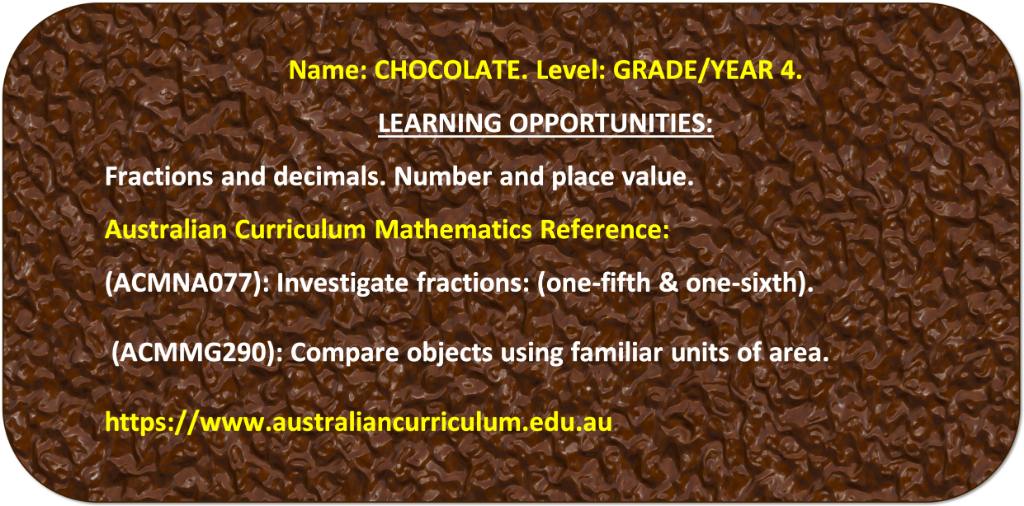
Chocolate - Worksheet
Reading Maps
GAME PLAYS ON: PC & LAPTOP ONLY
Reading Maps - Game Description
Ages: 9 – 10 years old
Suits: Grade 4 students in Australia, Fourth Grade students in the U.S.A. & Canada and Year 5 students in England.
Introducing the Cartesian coordinate system and ordered pairs in preparation for reading maps and interpreting graphs.
This game helps students learn how to read a grid map and to interpret a graph. It introduces the Cartesian coordinate system and ordered pairs.
Set on an alien planet with great sound effects, it is an exciting and very engaging way for students to learn the Cartesian coordinate system. Students are given maps and must locate the position of their spacecraft. It also teaches students how to read ordered pairs, an important concept to learn for students of this age.
The game is designed to suit the Mathematics Curriculums of Australia, Canada, England, and the U.S.A.
Teacher References:
(ACMMG090): Interpret information contained in basic maps.
Focusing on the Cartesian Coordinate System and Ordered Pairs.
Ref: Australian Curriculum Mathematics.
How To Play:
You are in a strange land on another planet, and you need to find your way back to your spacecraft. You have a map, but can you read it? Your spacecraft is shown on the map by a yellow circle.
Click on any of the maps. What is the position of the yellow circle?
Choose the correct answer, see the CLUE. Then DRAG your answer to the map above. Are you ready for the challenge?
Reading Maps - Learning Outcomes
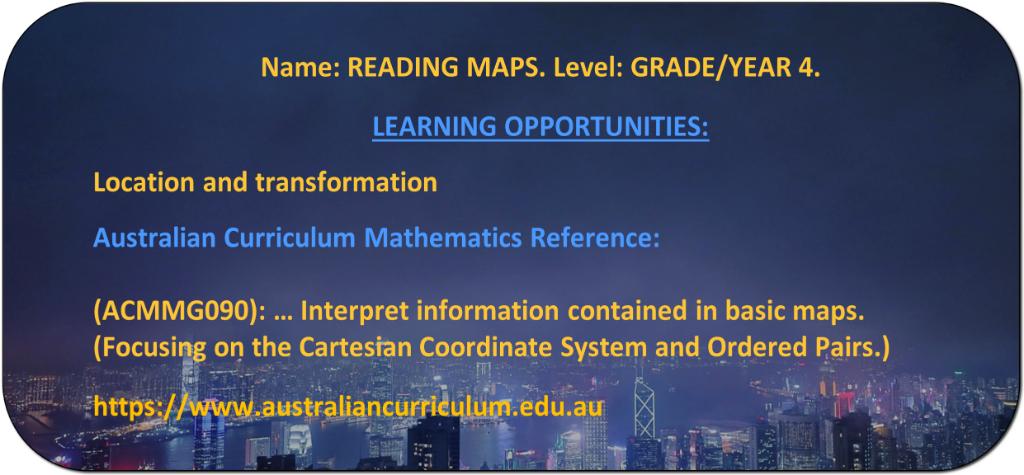
Reading Maps - Worksheet
Miss the Train – Standard
GAME PLAYS ON: PC & LAPTOP ONLY
Miss the Train - Standard - Game Description
Ages: 9 – 10 years old
Suits: Grade 4 students in Australia, Fourth Grade students in the U.S.A. & Canada and Year 5 students in England.
Helping students to recognise / recognize there are 60 minutes in an hour.
This game helps students to master reading the time. It is a challenging game for most students as they must subtract half an hour to times given. Time increments in this game are 15 minutes, making it a good easy introduction to subtracting time. The game uses both analogue and digital clocks and converting between them.
It is set at a railway station in the snow and students are told they have missed their train by 30 minutes. Students must then calculate what time the train left the station. It is an engaging way for students to learn time calculations.
The game is full of positive and encouraging words to build mathematical confidence and is a good gauge for teachers to judge if a student is proficient at reading the time. It is the first game of two “time” games for this level. It is designed to suit the Mathematics Curriculums of Australia, Canada, England, and the U.S.A.
Teacher References:
(ACMMG085): Convert between units of time. Identifying and using the correct operation for converting units of time.
(ACMMG086): Use “am” and “pm” notation and solve simple time problems.
Ref: Australian Curriculum Mathematics.
How To Play:
You were going on a train ride, but you missed your train! Your train departed half an hour ago. You must work out what time the train left. Click on a clock. Choose the correct time and DRAG your answer to the clock above! You can do it, don’t give up!
Miss the Train - Standard - Learning Outcomes

Miss the Train - Standard - Worksheet
Miss the Train – Advanced
GAME PLAYS ON: PC & LAPTOP ONLY
Miss the Train - Advanced - Game Description
Ages: 9 – 10 years old
Suits: Grade 4 students in Australia, Fourth Grade students in the U.S.A. & Canada and Year 5 students in England.
Students must recognise / recognize there are 60 minutes in an hour. This is the more challenging of the two-time subtraction games.
This game is designed to help students to read digital and analogue clocks. Students are about to go on a steam train ride in the countryside. But they are told, they have missed their train by 30 minutes. Students must then calculate what time the train left the station. It is an engaging way for students to learn time calculations.
The game is full of positive and encouraging words to build mathematical confidence and is a good gauge for teachers to judge if a student is proficient at reading the time. It is designed to suit the Mathematics Curriculums of Australia, Canada, England, and the U.S.A.
Teacher References:
(ACMMG085): Convert between units of time. Identifying and using the correct operation for converting units of time.
(ACMMG086): Use “am” and “pm” notation and solve simple time problems.
Ref: Australian Curriculum Mathematics.
How To Play:
Are you ready for a more challenging game? Once again, you missed your train! Your train departed half an hour ago. You must work out what time the train left. Click on a clock. Choose the correct time and DRAG your answer to the clock above! You can do it, don’t give up!
Miss the Train - Advanced - Learning Outcomes

Miss the Train - Advanced - Worksheet
TV Stars
GAME PLAYS ON: PC & LAPTOP ONLY
TV Stars - Game Description
Ages: 9 – 10 years old
Suits: Grade 4 students in Australia, Fourth Grade students in the U.S.A. & Canada and Year 5 students in England.
Breaking down large numbers to assist addition and multiplication.
This game helps students to understand addition and multiplication of large numbers. It teaches students how to regroup and rearrange large numbers for easier calculations. It is a good gauge for teachers to judge how well a student grasps addition and multiplication.
Students are contestants on a TV game show. They must add up the values of stars given to them for each problem. It is full of exciting sound effects and positive voice overs to encourage mathematical confidence. This game is designed to suit the Mathematics Curriculums of Australia, Canada, England, and the U.S.A.
Teacher References:
(ACMNA073): Apply place value to partition, rearrange and regroup numbers to assist calculations and solve problems. Recognising/recognizing and demonstrating that the place-value pattern is built on the operations of multiplication or division of tens.
Ref: Australian Curriculum Mathematics.
How To Play:
You are in the final on a TV game show. To play, you must match numbers to stars. Each star has points. You must add them up! Click on a set of stars. Add the points up. You will be given 4 answers, but only 1 answer is correct. Then DRAG your answer to the stars above. Do not use a calculator or pencil & paper! To win the final, you must finish all the cards with stars! You can do it, good luck!
TV Stars - Learning Outcomes

TV Stars - Worksheet
Downhill Skiing – Metric Standard
GAME PLAYS ON: PC, LAPTOP & TABLET
Downhill Skiing – Metric Standard - Game Description
Ages: 9 – 10 years old
Suits: Grade 4 students in Australia & Fourth Grade students in Canada as it uses the metric system.
Solving problems using fractions and decimals and the conversion between them.
This game helps students to understand fractions and their decimal representations. It includes fractions of quarters, halves, thirds, two-thirds & three-quarters and their decimal representations.
Students are asked to calculate the distance skied over a 100 m track, using fractions and decimals. Set in the snow with fun skiing sound effects and positive voice overs it is fun to play and encourages mathematical confidence. This game is designed to suit the Mathematics Curriculums of Australia & Canada.
Teacher References:
(ACMNA079): Make connections between fractions and decimal notation. Using a knowledge of fractions to establish equivalences between fractions and decimal notation.
Ref: Australian Curriculum Mathematics.
How To Play:
Your class is going on a skiing excursion! There is a competition to see who can ski the longest distance, without falling over! The track is 100 m long. Medals are awarded at the end of the day! Make sure everyone gets their own medal. You must give out all the medals to finish the game. Good luck and stay standing for as long as you can!
Downhill Skiing – Metric Standard - Learning Outcomes

Downhill Skiing – Metric Standard - Worksheet
Downhill Skiing – Imperial Standard
GAME PLAYS ON: PC, LAPTOP & TABLET
Downhill Skiing – Imperial Standard - Game Description
Ages: 9 – 10 years old
Suits: Fourth Grade students in the U.S.A., & Year 5 students in England, as it uses the imperial system.
Solving problems using fractions and decimals and the conversion between them.
This game helps students to understand fractions and their decimal representations. It includes fractions of quarters, halves, thirds, two-thirds & three-quarters and their decimal representations.
Students are asked to calculate the distance skied over a 100-yard track, using fractions and decimals. Set in the snow with fun skiing sound effects and positive voice overs it is fun to play and encourages mathematical confidence. This game is designed to suit the Mathematics Curriculums of the U.S.A, & England.
Teacher References:
(ACMNA079): Make connections between fractions and decimal notation. Using a knowledge of fractions to establish equivalences between fractions and decimal notation.
Ref: Australian Curriculum Mathematics.
How To Play:
Your class is going on a skiing excursion! There is a competition to see who can ski the longest distance, without falling over! The track is 100 yards long. Medals are awarded at the end of the day! Make sure everyone gets their own medal. You must give out all the medals to finish the game. Good luck and stay standing for as long as you can!
Downhill Skiing – Imperial Standard - Learning Outcomes

Downhill Skiing – Imperial Standard - Worksheet
Downhill Skiing – Metric Advanced
GAME PLAYS ON: PC, LAPTOP & TABLET
Downhill Skiing – Metric Advanced - Game Description
Ages: 9 – 10 years old
Suits: Grade 4 students in Australia & Fourth Grade students in Canada as it uses the metric system.
Solving more complex problems using fractions and decimals and the conversion between them.
This game helps students to understand fractions and their decimal representations. It includes all the fractions of the standard game: quarters, halves, thirds, two-thirds & three-quarters, but also introduces the fractions of one-fifth, two-fifths, four-fifths, and their decimal representations.
Students are asked to calculate the distance skied over a 1 km track, using fractions and decimals. Set in the snow with fun skiing sound effects and positive voice overs it is fun to play and encourages mathematical confidence. This game is designed to suit the Mathematics Curriculums of Australia & Canada.
Teacher References:
(ACMNA079): Make connections between fractions and decimal notation. Using a knowledge of fractions to establish equivalences between fractions and decimal notation.
Ref: Australian Curriculum Mathematics.
How To Play:
Now you are an expert skier! You have entered a competition to see who can ski the longest distance, without falling over! The track is 1 km long. Medals are awarded at the end of the day! Make sure everyone gets their own medal. You must give out all the medals to finish the game. Good luck and stay standing for as long as you can!
Downhill Skiing – Metric Advanced - Learning Outcomes

Downhill Skiing – Metric Advanced - Worksheet
Downhill Skiing – Imperial Advanced
GAME PLAYS ON: PC, LAPTOP & TABLET
Downhill Skiing – Imperial Advanced - Game Description
Ages: 9 – 10 years old
Suits: Fourth Grade students in the U.S.A., & Year 5 students in England, as it uses the imperial system.
Solving more complex problems using fractions and decimals and the conversion between them.
This game helps students to understand fractions and their decimal representations. It includes all the fractions of the standard game: quarters, halves, thirds, two-thirds & three-quarters, but also introduces the fractions of one-fifth, two-fifths, four-fifths, and their decimal representations.
Students are asked to calculate the distance skied over a 1000-yard track, using fractions and decimals. Set in the snow with fun skiing sound effects and positive voice overs it is fun to play and encourages mathematical confidence. This game is designed to suit the Mathematics Curriculums of the U.S.A, & England.
Teacher References:
(ACMNA079): Make connections between fractions and decimal notation. Using a knowledge of fractions to establish equivalences between fractions and decimal notation.
Ref: Australian Curriculum Mathematics.
How To Play:
Now you are an expert skier! You have entered a competition to see who can ski the longest distance, without falling over! The track is 1000 yards long. Medals are awarded at the end of the day! Make sure everyone gets their own medal. You must give out all the medals to finish the game. Good luck and stay standing for as long as you can!
Downhill Skiing – Imperial Advanced - Learning Outcomes

Downhill Skiing – Imperial Advanced - Worksheet
Expedition – Standard
GAME PLAYS ON: PC & LAPTOP ONLY
Expedition -Standard - Game Description
Ages: 9 – 10 years old
Suits: Grade 4 students in Australia, Fourth Grade students in the U.S.A. & Canada and Year 5 students in England.
Solving simple addition and subtraction problems.
This game helps students learn how to add and subtract and the connection between them. It is a good gauge for teachers to judge how well a student grasps addition and subtraction.
It is set in Antarctica with sounds of penguins and is a very calming way to learn mathematics. It also focuses on regrouping and rearranging large numbers for easier calculations. It is an engaging game and is full of positive and encouraging words to build mathematical confidence. It is designed to suit the Mathematics Curriculums of Australia, Canada, England, and the U.S.A.
Teacher References:
(ACMNA073): Apply place-value to partition, rearrange and regroup numbers to assist calculations and solve problems. Demonstrating that place-value pattern is built on the operations of multiplication or division of tens.
Ref: Australian Curriculum Mathematics.
How To Play:
You are an expert at addition and subtraction, and you have been given a job on a scientific expedition. Your job is to count penguins and you must check that all your TOTALS are correct. Click on one of the TOTALS on the start page. Only 1 of the 4 answers given is correct. Choose the correct answer and DRAG it to the TOTAL.
Take your time and use a pencil and paper. Keep doing this until you have done them all. You must do ALL the TOTALS to finish the game. You can do it!
Expedition -Standard - Learning Outcomes
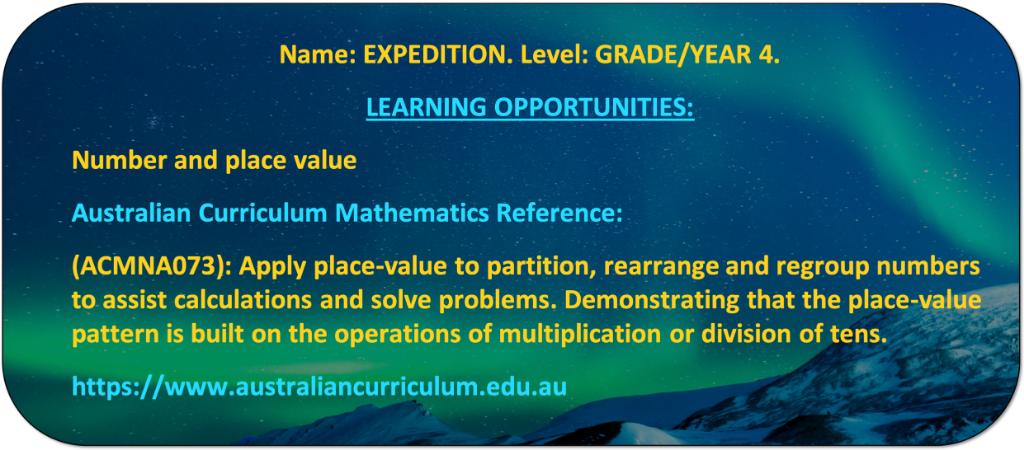
Expedition -Standard - Worksheet
Expedition – Advanced
GAME PLAYS ON: PC & LAPTOP ONLY
Expedition – Advanced - Game Description
Ages: 9 – 10 years old
Suits: Grade 4 students in Australia, Fourth Grade students in the U.S.A. & Canada and Year 5 students in England.
Advanced addition and subtraction.
This game involves slightly more complex addition and subtraction. It is still within most students’ capabilities, especially if played towards the end of the school year.
It is set in Antarctica with sounds of penguins and is a very calming way to learn mathematics. It also focuses on regrouping and rearranging large numbers for easier calculations. It is an engaging game and is full of positive and encouraging words to build mathematical confidence. It is designed to suit the Mathematics Curriculums of Australia, Canada, England, and the U.S.A.
Teacher References:
(ACMNA073): Apply place-value to partition, rearrange and regroup numbers to assist calculations and solve problems. Demonstrating that place-value pattern is built on the operations of multiplication or division of tens.
Ref: Australian Curriculum Mathematics.
How To Play:
You have now been promoted to chief data recorder on the scientific expedition. Now you must check that all SUMS are correct. Click on one of the SUMS on the start page. Only 1 of the 4 answers given is correct. Choose the correct answer and DRAG it to the SUM. Take your time and use a pencil and paper. Keep doing this until you have done them all. You must do ALL the SUMS to finish the game. Are you ready for the challenge? You can do it!
Expedition – Advanced - Learning Outcomes

Expedition – Advanced - Worksheet
Back to the Castle
GAME PLAYS ON: PC, LAPTOP & TABLET
Back to the Castle - Game Description
Ages: 9 – 10 years old
Suits: Grade 4 students in Australia, Fourth Grade students in the U.S.A. & Canada and Year 5 students in England.
Solving simple three-digit subtraction problems.
This game helps students learn how to solve subtraction problems that involve large numbers for this age group. Students must not use a calculator, so therefore they must rearrange and regroup numbers to find each answer.
Set at night on a pathway back to a castle, students must calculate how many steps remain to the castle door. It is an engaging game full of exciting Halloween sounds. This game is designed to suit the Mathematics Curriculums of Australia, Canada, England, and the U.S.A.
Teacher References:
(ACMNA073): Apply place-value to partition, rearrange and regroup numbers to assist calculations and solve problems. Demonstrating that place-value pattern is built on the operations of multiplication or division of tens.
Ref: Australian Curriculum Mathematics.
(This game also includes addition facts and related subtraction facts to develop increasingly efficient mental strategies for computation.)
How To Play:
You have spent too much time in the forest and now it is dark. You must get back to the castle safely. You know there are 568 steps back to the castle because you counted them on the way down. So now you count the steps as you climb back up. Sometimes you stop and work out how many steps are left to go. Work out how many steps you have left to climb until you reach the castle. Drag your answer to the black circle. See the CLUE. Are you prepared for your challenge?
Back to the Castle - Learning Outcomes

Back to the Castle - Worksheet
By the end of Grade 4, students choose appropriate strategies for calculations involving multiplication and division. They recognise common equivalent fractions in familiar contexts and make connections between fraction and decimal notations up to two decimal places. Students solve simple purchasing problems. They identify and explain strategies for finding unknown quantities in number sentences. They describe number patterns resulting from multiplication. Students compare areas of regular and irregular shapes using informal units. They solve problems involving time duration. They interpret information contained in maps. Students identify dependent and independent events. They describe different methods for data collection and representation, and evaluate their effectiveness. Students use the properties of odd and even numbers. They recall multiplication facts to 10 x 10 and related division facts. Students locate familiar fractions on a between units of time. They classify angles in relation to a right angle. Students list the probabilities of everyday events. They construct data displays from given or collected data.
https://www.australiancurriculum.edu.au

























